从目的论角度谈英文电影片名的翻译-精选文档
- 格式:docx
- 大小:10.42 KB
- 文档页数:4
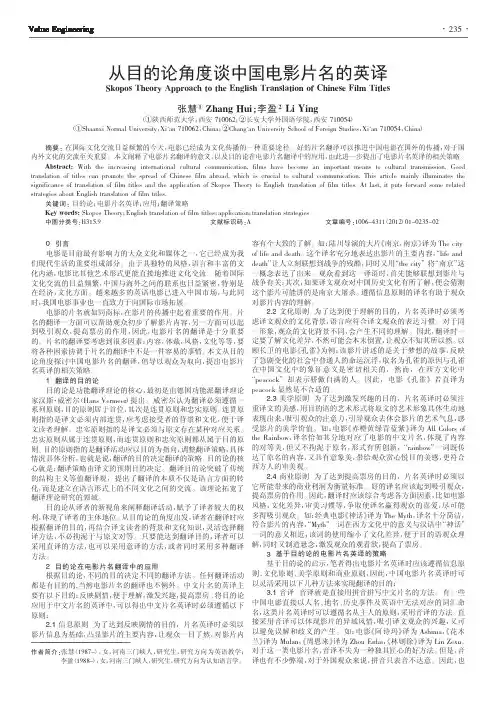
Value Engineering 0引言电影是目前最有影响力的大众文化和媒体之一,它已经成为我们现代生活的重要组成部分。
由于其独特的风格,语言和丰富的文化内涵,电影比其他艺术形式更能直接地推进文化交流。
随着国际文化交流的日益频繁,中国与海外之间的联系也日益紧密,特别是在经济,文化方面。
越来越多的英语电影已进入中国市场,与此同时,我国电影事业也一直致力于向国际市场拓展。
电影的片名就如同商标,在影片的传播中起着重要的作用。
片名的翻译一方面可以帮助观众初步了解影片内容,另一方面可以起到吸引观众,提高票房的作用,因此,电影片名的翻译是十分重要的。
片名的翻译要考虑到很多因素:内容,体裁,风格,文化等等,要将各种因素协调于片名的翻译中不是一件容易的事情。
本文从目的论角度探讨中国电影片名的翻译,倡导以观众为取向,提出电影片名英译的相关策略。
1翻译的目的论目的论是功能翻译理论的核心,最初是由德国功能派翻译理论家汉斯·威密尔(Hans Vermeer )提出。
威密尔认为翻译必须遵循一系列原则,目的原则居于首位,其次是连贯原则和忠实原则。
连贯原则指的是译文必须内部连贯,应考虑接受者的背景和文化,便于译文读者理解。
忠实原则指的是译文必须与原文存在某种对应关系。
忠实原则从属于连贯原则,而连贯原则和忠实原则都从属于目的原则。
目的原则指的是翻译活动应以目的为指向,调整翻译策略,具体情况具体分析,也就是说,翻译的目的决定翻译的策略。
目的论的核心就是:翻译策略由译文的预期目的决定。
翻译目的论突破了传统的结构主义等值翻译观,提出了翻译的本质不仅是语言方面的转化,而是建立在语言形式上的不同文化之间的交流。
该理论拓宽了翻译理论研究的领域。
目的论从译者的新视角来阐释翻译活动,赋予了译者较大的权利,体现了译者的主体地位。
从目的论的角度出发,译者在翻译时应根据翻译的目的,再结合译文读者的背景和文化知识,灵活选择翻译方法,不必拘泥于与原文对等。
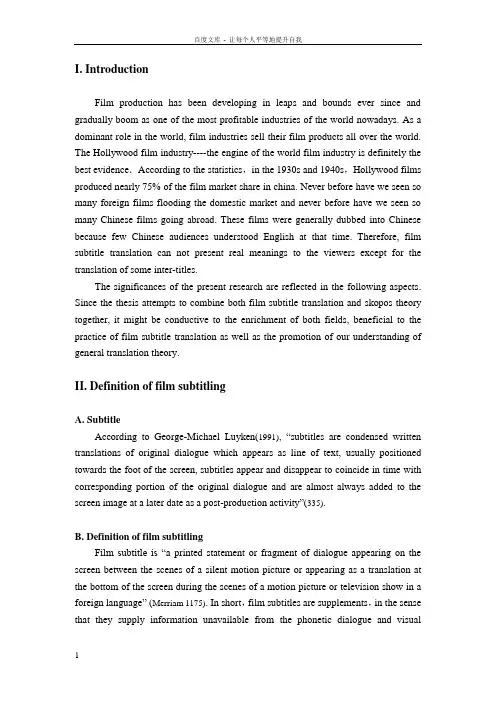
I. IntroductionFilm production has been developing in leaps and bounds ever since and gradually boom as one of the most profitable industries of the world nowadays. As a dominant role in the world, film industries sell their film products all over the world. The Hollywood film industry----the engine of the world film industry is definitely the best evidence.According to the statistics,in the 1930s and 1940s,Hollywood films produced nearly 75% of the film market share in china. Never before have we seen so many foreign films flooding the domestic market and never before have we seen so many Chinese films going abroad. These films were generally dubbed into Chinese because few Chinese audiences understood English at that time. Therefore, film subtitle translation can not present real meanings to the viewers except for the translation of some inter-titles.The significances of the present research are reflected in the following aspects. Since the thesis attempts to combine both film subtitle translation and skopos theory together, it might be conductive to the enrichment of both fields, beneficial to the practice of film subtitle translation as well as the promotion of our understanding of general translation theory.II. Definition of film subtitlingA. SubtitleAccording to George-Michael Luyken(1991), “subtitles are condensed written translations of original dialogue which appears as line of text, usually positioned towards the foot of the screen, subtitles appear and disappear to coincide in time with corresponding portion of the original dialogue and are almost always added to the screen image at a later date as a post-production activity”(335).B. Definition of film subtitlingFilm subtitle is “a printed statement or fragment of dialogue appearing on the screen between the scenes of a silent motion picture or appearing as a translation at the bottom of the screen during the scenes of a motion picture or television show in a foreign language” (Merriam 1175). In short,film subtitles are supplements,in the sense that they supply information unavailable from the phonetic dialogue and visualpicture.Film subtitles are different from “displays” or “captions”. “Displays” are “fragments of text recorded by the camera-letters, newspapers, headlines, banners etc” (Gottlieb l01-121). “Captions” (or “top titles”) are pieces of “textual information usually inserted by the program maker to identify names,places or dates relevant to the story line”(Luyken). This distinction is maintained here and “subtitles”do not include displays or captions, unless otherwise stated.Film subtitle can be both “intralingual”(and “vertical”), when the target language is the same as the source language, and “intralingual” (or “diagonal”), when the target language is different from the source language (Gottlieb 249-258). “Film subtitle”in this thesis is used to refer to interlingual film subtitle, unless otherwise stated.Film subtitle can be “open”, when the target text constitutes a physical part of the translated film and is transmitted together with the film sound and image,or “closed”, when the target text is stored in a digital/teletext format which is transmitted in as well as accessed via a separately coded channel at the discretion of the viewers(Gottlieb 247). In this thesis, “film subtitle”, refers to open film subtitle, unless otherwise stated.III. A brief introduction to skopostheorieA. The process of skoposSkopos is the Greek word for “aim” or “purpose” and was induced into translation theory in the 1970s by Hans J. Vermeer as a technical term for the purpose of a translation and of the action of translating skopos focuses on the purpose of the translation, which determines the translation methods and strategies that are to be employed in order to produce a functionally adequate result, the target text (TT), called the translatum by Vermeer (20-23). Therefore,in skopos theory,knowing why an source text (ST) is to be translated and what the function of the TT will be are crucial for the translator.In the 1970s there appeared a school in translation studies in Germany functionalism. Katharina Reiss firstly pointed out in his work Translation Criticism (2004). The representatives are Katharina Reiss, Hans J. Vermeer and Christiane Nord. They hold that translation is a kind of action with a purpose. This theory is first presented by Reiss and Vermeer in their book Grundlegung einer allgemeinen Translationstheorie (1984) (General Foundations of Translation Theory).Since 1978, German translation theorist H. J. Venneer, who breaks through thetraditional equivalence-based the theory that centers on source text,creates the skopostheories with the translation purpose or function of a translation as a general principle on the basis of theory of action(23-24). It is generally agreed now that translation is a type of human action. According to Vermeer, human action is intentional and purposeful behavior that takes place in a given situation, which modifies the situation at the same time (205-210). Skopos argues that the shape of target text should above all be determined by the function or “Skopos”that it is intended to fulfill in the target context.Vermeer believes that the purpose of a target text determines the translation strategies. In his opinion, the purpose of a target text, which is so important, is great extent decided by target readers, cultural background. In Hans J Vemeer’s Skopos and Commission in Translational Action(1989),Vemmer puts the Skopostheorie in this way:“Any form of translation action, including therefore translation itself, maybe conceived as an action, as the name implies. Any action has an aim, a purpose. The word Skopos, then, is a technical term for the aim or purpose of a translation.” In her book Translating as a Purposeful Activity: Functionalist Approaches Explained (2001), Christiane Nord defines the skopostheorie that “Skopos is a Greek word for purpose”(13-14). According to skopostheorie (the theory that applies the notion of Skopos to translation), the prime principle determining any translation process is the purpose (skopos) of the overall translational action. This fits in with intentionality being part of the very definition of any action.B. Three rules of the SkopostheorieSkopos theory involves three rules, i. e. skopos rule, coherence rule and fidelity rule, which will be discussed as follows.1. Skopos ruleVermeer postulates that as a general rule it must be the intended purpose of the target text that determines translation methods and strategies. From this postulate, he derives the skopos rule: Human action(and its subcategory:translation) is determined by its purpose(Skopos), and therefore it is a function of its purpose(Baker 236).Vermeer explains the Skopos rule in the following way,“Each text is produced for a given purpose and sho uld serve this purpose. The skopos rule thus reads as follows: translate/interpret/speak/write in a way that enables your text/translation to function in the situation in which it is used and withthe people who want to use it and precisely in the way they want it to function” (29).It is also pointed out that most translational actions allow a variety of skopos, which may be related to each other in a hierarchical order, and the translator should be able to justify their choice of a particular skopos in a given translational situation in translation, ., the skopos must be decided separately in each specific case.Skopos rule helps the translator solve the eternal dilemmas of free vs. faithful translation, dynamic vs. formal equivalence, and so on. Nord points out that the skopos of a particular translation task may require a “free” or a “faithful” translation, or anything between these two extremes, depending on the purpose for which the translation is needed. (29).2. The coherence ruleTwo further general rules are the coherence rule and the fidelity rule. The coherence rule stipulates that the target text must be sufficiently coherent to allow the intended users to comprehend it, given their assumed background knowledge and situational circumstances.The coherence rule, or in Vermeer’s terms, the standard of “intra-textual coherence” means “the receiver should be able to understand it: it should make sense in the communicative situation and culture in which it is received”(Nord 32). The coherence rule specifies that “a t ranslation should be acceptable in a sense that it is coherent with the receivers’ situation” (Nord 32).That is to say, the translator’s task is to produce a text that is at least likely to be meaningful to target-culture receivers, namely, to be coherent with the receivers’situation and thus to be understood by the receivers. Only when the receivers understand it as being sufficiently coherent with their situation, can this communicative interaction be regarded as successful.3. The fidelity ruleHowever, just being coherent with the target situation is not enough. A translation is an offer of information about a preceding offer of information; therefore there is a relationship between the translation and the source text. Vermeer calls this relationship “inter-textual coherence or “fidelity”. This is postulated as a further principle, referred to as the “fidelity rule” (Nord 32)“Inter-textual coherence should exist between source and target text, while the form it takes depends both on t he translator’s interpretation of the source text and on the translation skopos” (Nord 1-32). For example, one possible kind of inter-textualcoherence could be a maximally faithful imitation of the source text.We know that the source text is intended for the source culture receivers instead of translation,therefore when it is translated for the different target-culture recipients, maybe the function of the target text or the purpose of the translation is different from that of the source text. In this case,the “fidelity rule” should give way to the skopos rule. However, the translator should aim for any possible compatibility between the skopos and inter-textual coherence.The three basic rules of the skopostheorie are designed to govern the translator’s activities in the whole translation process. In most cases, due to the reason that the skopos of the translation is frequently likely to deviate from the intention of the corresponding source language text, a translation cannot satisfy the three rules at the same time.IV. Film subtitle translation of If You Are the One from the perspective of skopostheorieIn subtitle translation of If You Are the One, in particular, its skopos is determined by the intention of its director as the initiator and the expectation of the English speaking viewers as the receivers of the English subtitles; its shape is determined by its skopos and the subtitler. This part is to analyze how the factors mentioned above determine the skopos and shape of translated subtitles in If You Are the One, and how strategies are employed to fulfill its skopos.A. Brief review of the film If You Are the OneThe film for 2008, If You Are the One, stars Feng’s longtime collaborator, Ge You, as a man in his 40s, newly rich, looking to settle down and start a family. Having made an instant fortune through his sale of the Conflict Resolution Terminal 2008, middle-aged entrepreneur Qin Fen (Ge You) turns his attention to finding a wife. Using all online personals service, he auditions potential spouses, but few make a lasting impression. Qin Fen’s stalwart personality is partly to blame;he’s intent on finding a suitable match,and is willing to walk away from even an absolute goddess if there’s a hint of incompatibility. So it goes with comely flight attendant Smiley Liang (Shu Qi), who Qin Fen initially recognizes as a poor match. Regardless, the two commiserate over drinks, where the melancholy Smiley reveals that she’s dating amarried man (Alex Fong). The two parts intends never to meet again, with each returning to their own pursuit of love.But as fate and the screenwriters would have it, Qin Fen and Smiley meet again on all airline flight,with Smiley working, Qin Fen traveling, and Smiley’s boyfriend and wife also present. The coincidence draws Qin Fen and Smiley back together, propelling them on the road to friendship and perhaps more, with occasional stops at fine luxury entertainment locations, where they sip expensive drinks while verbally sparring over their views on love. Qin Fen aims for a home run with his potential mate, while Smiley seems willing to settle if she can’t have her idealized,unattainable love. In response, Qin Fen tries to convince her otherwise while attempting not to appear as he’s trying to. It’s the story of one man’s tough love, except with a picturesque tour of fabulous locations that only people with money can visit. Somewhere in there, Qin Fen’s loyalty and stalwart affection is supposed to comfort Smiley’s wounded heart or something like that.B. An analysis of subtitle translation of If You Are the One based on skoposIn subtitle translation of If You Are the One, in particular, its skopos is determined by the intention of its director Feng Xiaogang as the initiator and the expectation of the English-speaking viewers as the receivers of the English subtitles; its shape is determined by its skopos and the subtitler. This part is to analyze how the factors mentioned above determine the skopos and shape of translated subtitles in If You Are the One and how the strategies are employed to fulfill its skopos.1. Feng Xiaogang’s intentionFeng never denies his wish to defeat the Hollywood films at the box office by adapting Hollywood’s game rules (Rosen 336).Feng discloses that the Associate President of Columbia Pictures, once said to him, “Your films have never been shown in overseas countries and thus you are not known to the viewers outside your country.Big Shot’s Funeral serves as an advertisement to publicize you and I hope it can provide the foundation for your second and third film in the overseas market” (Feng 187). From Mr. Geris’s wish, we can also find F eng’s ambition to gain the market share in foreign countries. And the film If You Are the One has proved to be well received in the North American market.Feng recalls in his book that on a seminar about the making of Big Shot’s Funeral,some people asked him whether the production strategy of the film should beconsidered as Hollywood’s cultural invasion into Chinese film industry. He replies that “it is a win-win deal and a two-edged sword” and that this kind of cooperation is cost-efficient because it “still makes Chinese films,but faces the global market” (Feng 187). As for Feng Xiaogang, the way to revive domestic market and march into international market is to cooperate with foreign film production companies and internationalize domestic film success.From above,we can see that the director’s intention is to bridge the gap between Chinese and foreign cultures and gain market share in foreign countries,which is the major part of translation brief.2.Skopos analysisTo define the skopos, we should verify the translation brief. Although it is said that a brief should be given by the clients, more often than not, it is not the case. Then a translator should have the ability to verify it by himself. The translation brief of the present case could be specified as follows:a. The intended text functions: the main function of the TT is referential. If You Are the One is more a commercial movie than art,the intended text function is first of all referential, to provide information about what is going on the screen. Then it may come the expressive function to relay the sender’s attitude and feelings. The translator must weigh against different functions and decide on the main one. In the present case,it is the referential function that wins the upper hand. Translator has to make a choice according to the skopos of the translation of film subtitle. Feng’s film subtitle translation aims to win the target market so that translator has to produce clear and concise subtitled film dialogues bridging the cultural gaps and make the narrative easily accessible for the audience.Thus, the target audience will find it easier to accept and understand the translated subtitles. Here are some examples.(1)秦奋:不算老实但天生胆小I'm no angel杀人不犯法我也下不去手Just too cowardly to do wrongThe west and east have different religious beliefs. In Christianity, Angel is a good spirit who is kind, lovely and innocent. Here, Qin Fen describes himself as a man who is not well-behaved.So he is not like an angel.(2)别猫哭耗子了Spare me the alligator tearsIn China, there is a proverb“猫哭耗子假慈悲”. This means the cat pretends to be sympathetic to the death of the mouse because she can have it as a meal. In western culture, people think that while having meals, usually an animal, an alligator will shed tears. So alligator tears implies disguised sympathy.(3)有的人是情人眼里才是西施Beauty is in the eyes of the beholder不过分的说, 仇人眼里你都是西施But no exaggeration, even to a foe,you’d be beautifulThe above underlined words or proverbs are all culture-loaded. Domestication is adopted to make the western audience fully understand the film.b. The addressees:It is self-evident that the TT addressees in subtitle translation are the foreign audience, probably adults, who share a different culture background and who are lay of Chinese. To be specific, they are common people who watch it for entertainment and film festival juries who view it with a discerning eye, eg.秦奋:那咱俩要是结婚了So,if we get married非得倒插门我去你们那儿吗I have to go to live with your family?In China, in most cases,after marriage, the wife lives with the husband’s family. “倒插门”means the husband lives with wife’s family. In this sentence, it is deleted since it expresses the same meaning as “我去你们那儿”.c. The time and place of text reception: The time and space of reception is less controversial,which vary in different cases. In this case, the time is up to now from 2008 when it was released to the public and the place is at the very beginning cinema and later on amounts to a wide range of places thanks to the development of technologies such as DVD.So far, the skopos of the translation can be defined as to supplement the film by providing the optimal information for the audience in written form within a limited time and space.V. Film subtitle translation of Curse of the Golden Flower from the perspective of skopostheorieIn this part, the subtitle translation of Curse of the Golden Flower is analyzedwith the background of the skopos theory.A. Background of Curse of the Golden FlowerCurse of the Golden Flower is derived from the story Thunderstorm, one of the best-known masterpieces by the most famous Chinese playwright Cao Yu. But the adaptation doesn’t stay too faithful to the original. The film is a historical drama directed by Zhang Yimou who also co-wrote the screenplay in Chinese. The screen version is established in the 10th century during the short-1ived Late Tang Dynasty, about a thousand years ago.For today’s viewers,it is a story about court intrigues and deceptions. Moreover there are several pivotal factors within the plot, among which, traditional Chinese medicine is the foremost one since the Emperor in the film is gradually poisoning his wife, the Empress, by adding a deadly fungus to her medicine. Zhang Yimou the director gives his explanation of the arrangement that “as for the Emperor’s personality, well, he’d love to stay in the royal pharmacy all the time. He’s a drug freak. That’s how his character is developed and expanded upon. He’s just so into the drug”.B. An analysis of subtitle translation of Curse of the Golden Flower based onskoposThe title of the movie,which is literally translated as “The Whole City is Clothed in Golden Armor”, is the last line taken from a Tang Dynasty poem---Do not Endow with Chrysanthemum Behind written by Huang Chao who rose in rebellion in 875 and died 9 years later.After changing the title several times, the screenwriters as well as the director finally settle on the poem for the reason that it indicates the rebellion taken by the Prince against the Emperor in the movie. The Chinese audience may easily understand the cultural connotation while the English-speaking audience who are not familiar with the background of the poem, due to the great disparity in terms of cultural background, may not comprehend the implicit aspects of the title without the explanatory message or footnote. Consequently, this kind of culturally loaded expressions will put a lot of processing efforts on the target audience. In addition, with the constraints of time and space, if they focus on the reading of the subtitle, they will lose some of the visual and audio information.To solve this problem, the subtitler discards the Chinese title and adapts a new one with the image of the golden flower taken as a symbol to reveal the palace intrigue and the machination of power play to the target audience. The golden flower is designed to function as the symbol of rebellion, which is the same as the title. Hence its images appearing in the film once and again will, in another form, retrieve the loss of the culturally loaded information caused by the substitution since film is a multidimensional art involving visual images, sound, colors and so on. Let’s see some examples:(1)辰时的药煎好了Your Majesty’s medicine for the hour is ready(2)执令官统领后宫羽林军The Imperial Guards protect our private palacesIt is no easy job to translate cultural elements in subtitle translating. The underlined parts of the source text are omitted in the target text since these cultural elements do not deliver adequate information and there is no time to explain all details. Their function can be retrieved by the image and the subtitler is careful enough not to omit information that could at a later stage be essential for the understanding of the story.According to adequacy and equivalence theory, the translator can not offer the same amount and kind of information as the source-text producer. What the translator does is to offer another kind of information in another form (Reiss & Vermeer 123). Located in a broader ecological culture, the subtitling succeeds in producing a communicative interaction in the target text. We may find another example in this film:(3)当年你只是一个小小的都尉At that time,you were only a lowly captain.“都尉”here refers to the low-ranking officer in Tang Dynasty. If a simple transliteration as “Duwei”is adopted, it is completely meaningless to the English-speaking audience and fails to achieve intra-textual coherence. Whether to translate the complete meaning of “Duwei”, on the other hand, makes no difference to the comprehension of the plot for the source text producer just means that the Emperor mounts the throne from the bottom. Therefore the subtitler, by chunking it up, translates it into “a lowly captain” to establish inter-textual coherence as well as intra-textual coherence in the target text.(4)儿臣为了母后从此不再服药You will never drink the poison again.In the film, what the Empress drinks is a kind of Chinese medicine containing the ingredient that will cause a person to lose his or her entire mental faculty. According to traditional Chinese medicine, any medicine has 30% poison ingredients. Therefore some ingredients are useful as well as poisonous. Their curative value is restricted to certain diseases and certain dosage based on the theory of using poison to cure poison. These ingredients belong to the category of medicine despite of their toxicity. By chunking down the medicine into poison, the subtitler defines the meaning in the narrowest sense and makes the implicit information explicit to accomplish intra-textual coherence in the target text.VI. ConclusionA. ContributionSkopostheorie provides translators with a whole new perspective into translation action. This paper conducts a systematic analysis of crucial factors that influence the strategies of subtitle translation, in which skopostheorie is adopted to guide the descriptive and explanatory analysis.On the basis of the above analysis, this paper gets some enlightenment of skopostheorie on subtitle translation. The enlightenment of “intra-textual coherence”on subtitle translating is that the target receiver should be able to understand the translated version of subtitle. And the translated version should make sense in the communicative situation and culture in which it is received. The subtitler should always keep the target viewers in mind. After exploring the main components of skopostheorie and analyzing the specific constraints in film subtitle translation, the author tries to find out some enlightenment of skopostheorie on subtitle translation. In order to find out the enlightenment, this paper analyzes Feng Xiaogang’s film in light of skopostheorie. The film If You Are the One proves to be successful in its target market. Therefore, this paper tries to find out influencing factors that affect the subtitler’s choice of strategies.The author gives focus to the skopos of subtitle translation, the more influencing role of the film director in subtitle translation and the importance of target audience. With reference to skopostheorie,subtitle translating is a purposeful activity and thepurpose of the whole translational action is the prime principle that determines the translation process. The basic purpose or skopos of subtitle translation is to aid the viewers with a translated film dialogue, to provide them with the most relevant information in the most effective way within its specific constraints,to help them in understanding what’s happening on the screen with ease.B. LimitationsOwing to the limitations of time and space,the source data collected for the thesis is limited. Meanwhile because of the knowledge limitations this paper can not deeply analyzes the translation of Chinese film subtitles into English ones from the perspective of skopostheorie. It is the author’s sincere wish that if possible, in the future, further research can be done on comparative study on Chinese-English translation and English-Chinese translalion of film subtitles.Work CitedBaker, Mona. Routledge Encyclopeata of Translation Studies. Shanghai:Shanghai Foreign Language Education Press(2004):Baker,Christiane, Nord. Translating as a Purposeful Activity: Functional Approaches Explained.Shanghai: Shanghai Foreign Language Education Press, 2001.Feng, X. G[冯小刚]我把青春献给你武汉:长江文艺出版社2003: 187Gottlieb, H. Teaching Translation and Interpreting. Amsterdam: John Benjamins Publishing Company, 1998Gottlieb, H. Media Translation. Amsterdam/Philadelphia: John Benjamins Publishing Company, 2001Gottlieb, H. Subtitfing: Diagonal translation In C. Dollerup et al. (eds), Perspectives Studies in Translatology. Copenhagen: University of Cpenhagen, 1994 l01-121.Gottlieb, H. Anglicisms and TV Subtitles in an Anglified World: [A] Gambier Yves, 249-258 Gottlieb, H.Subtitling-a new university discipline in Teaching Translating and Interpreting. (eds) Dollerup, Cay&A. . Amsterdam: John Benjamin. 1998: 247Katharina, Reiss. Translation Criticism: The Potentials&Limitations. Shanghai: Shanghai Foreign Language Education Press, 2004.Katharina, Reiss and Hans J. Vermeer. Grundlegung einer allgemeinen Translationstheorie.Tubingen:Niemeyer, 1984,Michael. Overcoming Language Barriers in Television. [M] Manchester: European Institute forthe Media 1991.Luyken,George-Michael. Overcoming Language Barriers in Television. [M] Manchester: European Institute for the Media 1991.Merriam-Webster. Merriam Webster's Collegiate Dictionary. 1997:1175Rosen,S.(2002).狼来了:好莱坞与中国电影市场,. 全球化与中国影视的命运336-360. (S.Y Sun, Trans.). Shanghai: Shanghai Foreign Language Education Press. 1994-2000 Vermeer, Hans J. Skopos and Commission in Translational Action in Chesterman(ed). 1989, 20-233.。
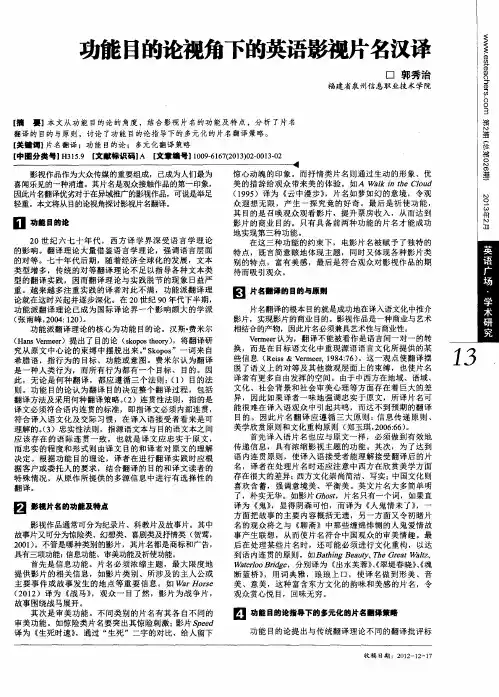
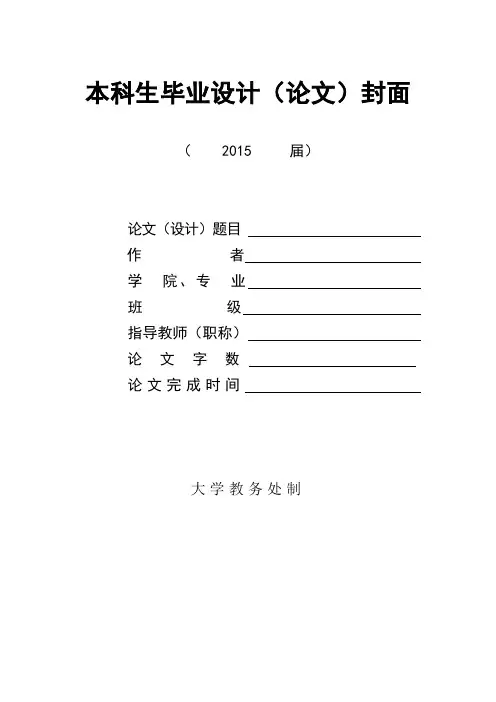
本科生毕业设计(论文)封面( 2015 届)论文(设计)题目作者学院、专业班级指导教师(职称)论文字数论文完成时间大学教务处制英语原创毕业论文参考选题(200个)一、论文说明本写作团队致力于英语毕业论文写作与辅导服务,精通前沿理论研究、仿真编程、数据图表制作,专业本科论文3000起,具体可以联系qq 805990749。
下列所写题目均可写作。
部分题目已经写好原创。
二、原创论文参考题目1、(英语毕业论文)春晚流行语的社会语言学和修辞学研究(开题报告+论)2、(英语毕业论文)从奈达的动态对等理论比较研究《德伯家的苔丝》的两个中文译本(开题报告+论文+文献综述)3、(英语毕业论文)浅析《汤姆叔叔的小屋》中黑奴的命运4、(英语毕业论文)归化和异化策略在《红楼梦》文化负载词翻译中的应用(开题报告+论文+文献综述)5、(英语毕业论文)人性的苏醒—《香蕉鱼的好日子》主题研究6、(英语毕业论文)A Study of Cultural Differences Reflected in Chinese and English Proverbs(开题报告+论文+文献综述)7、(英语毕业论文)《喜宴》中反映出的中西文化差异8、(英语毕业论文)平行文本比较模式指导下的公司简介翻译(开题报告+论文+文献综述+外文翻译)9、(英语毕业论文)主位推进模式在语篇翻译中的应用(开题报告+论文)10、(英语毕业论文)诸神形象折射中西方价值观不同(开题报告+论文+文献综述)11、(英语毕业论文)从合作原则和礼貌原则的角度分析赵丽蓉的小品(开题报告+论文)12、(英语毕业论文)Communicative Functions of Silence in Conversations13、(英语毕业论文)从女性主义分析《红字》与《傲慢与偏见》14、(英语毕业论文)英语谚语重复修辞格的翻译15、(英语毕业论文)从《百舌鸟之死》探析美国种族冲突16、(英语毕业论文)英语词汇在日常生活中对现代汉语词汇的影响17、(英语毕业论文)高中英语“后进生”产生的原因以及补差方法研究18、(英语毕业论文)英汉习语翻译中文化意象的转换(开题报告+论文+文献综述)19、(英语毕业论文)Judy’s Double Character in Daddy-Long-Legs20、(英语毕业论文)浅析《乞力马扎罗的雪》的现代主义特征(开题报告+论文+文献综述)21、(英语毕业论文)从《厄舍古屋的倒塌》看爱伦坡写作的哥特式风格(开题报告+论文)22、(英语毕业论文)从动态对等角度分析中国旅游景点名称英译——以中国庐山网为例23、(英语毕业论文)“金玉良缘”与“幸福终点”——浅析中西婚姻差异24、(英语毕业论文)The Application of Cooperative Learning in High School English Teaching(开题报告+论文+文献综述)25、(英语毕业论文)The Glossology and Translation of Rhetorical Devices of Harry Potter26、(英语毕业论文)《觉醒》与《欢乐之家》中的女性形象和女权思想之比较(开题报告+论文)27、(英语毕业论文)海明威在《永别了,武器》中的反战情绪(开题报告+论文)28、(英语毕业论文)A Chinese-English Translation of Public Signs Based on Nida's Fuctional Equivalence Theory29、(英语毕业论文)《红字》中海斯特性格分析(开题报告+论文+文献综述)30、(英语毕业论文)从《狼图腾》和《野性的呼唤》中狼的意象比较中西方生态意识(开题报告+论文)31、(英语毕业论文)教师在初中教学中对学生的评价32、(英语毕业论文)浅析《喜福会》中母女冲突的存在与消融33、(英语毕业论文)从《肖申克的救赎》看美国的个人英雄主义(开题报告+论文)34、(英语毕业论文)从模因论角度下谈广告语的仿译(开题报告+论文)35、(英语毕业论文)功能目的论视角下的仿拟翻译的应用分析(开题报告+论文)36、(英语毕业论文)On the Racial Discrimination in America in Beloved(开题报告+论文+文献综述)37、(英语毕业论文)《宠儿》中塞斯的性格分析(开题报告+论文+文献综述)38、(英语毕业论文)An Analysis of Conversational Implicature In Pride and Prejudice (开题报告+论文+文献综述)39、(英语毕业论文)言语行为理论视角下的商务索赔信函话语分析40、(英语毕业论文)隐喻在英语委婉语中的应用41、(英语毕业论文)浅析虚词在英语写作中的重要性42、(英语毕业论文)从对立到和谐—解读伍尔夫《到灯塔去》的女性主义43、(英语毕业论文)顺应论视角中电影字幕汉英翻译研究——以李安电影作品字幕翻译为例(开题报告+论文+文献综述+外文翻译)44、(英语毕业论文)浅析卡夫卡小说中的荒诞意识(开题报告+论文)45、(英语毕业论文)中西方饮酒礼仪的比较46、(英语毕业论文)The Racial Stereotypes in American TV Media47、(英语毕业论文)《劝导》中安妮•艾略特的道德判断(开题报告+论文+文献综述)48、(英语毕业论文)从唐诗不同译本看数字词汇翻译得与失49、(英语毕业论文)分析托马斯•哈代对西奥多•德莱塞的文学影响50、(英语毕业论文)目的论指导下《页岩》英译汉中的词类转译现象(开题报告+论文+文献综述+外文翻译)51、(英语毕业论文)海明威“冰山原理”在《永别了,武器》中的应用及对写作的指导意义(开题报告+论文)52、(英语毕业论文)英语广告语中隐喻的研究(开题报告+论文)53、(英语毕业论文)Application of TPR Teaching Method in Facilitating Pupils' English V ocabulary Learning(开题报告+论文+文献综述)54、(英语毕业论文)Grammatical Analysis of Academic Writing55、(英语毕业论文)《善良的乡下人》的喜剧性分析56、(英语毕业论文)初中英语词汇教学57、(英语毕业论文)从构式视野下对英语图式习语的解读58、(英语毕业论文)On Freudian Interpretation of Dreams In Sense and Sensibility(开题报告+论文+文献综述)59、(英语毕业论文)论关联理论在商业广告翻译中的运用(开题报告+论文+文献综述)60、(英语毕业论文)分析埃里森《隐形人》中美国的种族歧视61、(英语毕业论文)Influence of Western Food Culture upon Chinese People62、(英语毕业论文)论《宠儿》中的美国黑人女性的悲剧成长(开题报告+论文+文献综述)63、(英语毕业论文)从关联理论看《茶馆》两个英译本中修辞格的处理(开题报告+论文+文献综述+外文翻译)64、(英语毕业论文)On Critical Realism in Oliver Twist(开题报告+论文+文献综述)65、(英语毕业论文)比较中美民事诉讼文化的价值取向(开题报告+论文+文献综述)66、(英语毕业论文)Psychological Analysis of Holden in The Catcher in the Rye(开题报告+论文+文献综述)67、(英语毕业论文)Elements of Chinese Culture in Wallace Stevens’Poems68、(英语毕业论文)从顺应论的角度谈英文电影片名的汉译(开题报告+论文)69、(英语毕业论文)论莎士比亚的宗教思想70、(英语毕业论文)从目的论的角度比较研究《茶馆》的两个英文译本(开题报告+论文)71、(英语毕业论文)中美价值观的比较--以《老友记》为例(开题报告+论文+文献综述)72、(英语毕业论文)从文化角度看中英房地产广告差异(开题报告+论文)73、(英语毕业论文)探讨武侠和骑士形象的异同74、(英语毕业论文)《紫色》中“家”的解读(开题报告+论文+文献综述)75、(英语毕业论文)论《简•爱》中伯莎•梅森的疯癫(开题报告+论文)76、(英语毕业论文)关于英语课堂中教师体态语的研究77、(英语毕业论文)电影英文片名汉译的原则(开题报告+论文+文献综述)78、(英语毕业论文)浅谈商务英语于商务信函中的运用(开题报告+论文+文献综述)79、(英语毕业论文)《嘉莉妹妹》中女主人公美国梦的幻灭(开题报告+论文)80、(英语毕业论文)浅析《两个新嫁娘》中的不同婚姻观81、(英语毕业论文)A Study of Neo-Classicism82、(英语毕业论文)试析《到灯塔去》中的女性主义83、(英语毕业论文)海明威《印第安人营地》新解84、(英语毕业论文)《麦田里的守望者》男主人公霍尔顿的人物形象分析85、(英语毕业论文)公益广告的词汇特点: 以美国红十字会广告语为例86、(英语毕业论文)源于真爱的结合:简爱的婚姻对当代人的启示87、(英语毕业论文)美剧字幕中的译者主体性——以美剧Gossip Girl第一季为例(开题报告+论文+文献综述+外文翻译)88、(英语毕业论文)Comparisons between Chinese Educationists and Western Educationists89、(英语毕业论文)探讨图式理论对英语专业四级阅读中的指导作用90、(英语毕业论文)杰克•伦敦《热爱生命》中天气描写的作用91、(英语毕业论文)Risk Comparing of Documentary Collection and Letters of Credit92、(英语毕业论文)对比分析中美可乐广告中的文化差异(开题报告+论文)93、(英语毕业论文)论功能对等原则下的商标翻译94、(英语毕业论文)从关联理论看《阿甘正传》的字幕翻译95、(英语毕业论文)从电影《姐姐的守护者》分析人的自私性(开题报告+论文)96、(英语毕业论文)The Interpretation to Captain Ahab in Moby Dick through Abnormal Psychology97、(英语毕业论文)礼貌原则框架下化妆品广告语篇研究(开题报告+论文)98、(英语毕业论文)Application of Foregrounding Theory to Translation of Simile and Metaphor99、(英语毕业论文)现代人对超人的需求--超人形象演变综述100、(英语毕业论文)基督教及《圣经》对西方文化的影响101、(英语毕业论文)由女性“奴性”潜意识解析玛利娅姆多舛命运(开题报告+论文)102、(英语毕业论文)浅谈《当幸福来敲门》中的美国个人主义103、(英语毕业论文)浅析《飘》中斯嘉丽的婚姻观(开题报告+论文)104、(英语毕业论文)高级英语课堂中教师角色研究(开题报告+论文+文献综述)105、(英语毕业论文)英语新词的发展研究(开题报告+论文)106、(英语毕业论文)从女性主义视角分析《纯真年代》中两位女主人公的不同爱情观(开题报告+论文+文献综述)107、(英语毕业论文)基本数字词在中西文化中的差异与翻译(开题报告+论文)108、(英语毕业论文)《劝导》中安妮•艾略特的道德判断(开题报告+论文+文献综述)109、(英语毕业论文)中介语对二语习得的影响探究(开题报告+论文+文献综述)110、(英语毕业论文)中餐菜谱翻译的错误分析111、(英语毕业论文)Culture Teaching in College English Listening Classrooms112、(英语毕业论文)商务英语翻译中的隐喻研究(开题报告+论文)113、(英语毕业论文)文化交际视野下的语用失误分析(开题报告+论文+文献综述)114、(英语毕业论文)希腊神话对英语语言的影响(开题报告+论文)115、(英语毕业论文)希拉里退选演讲积极话语分析116、(英语毕业论文)从中美高校的课堂教学模式看两国的文化差异(开题报告+论文+文献综述)117、(英语毕业论文)从传递文化信息视角探讨《红楼梦》翻译中“异化”与“归化”策略(开题报告+论文)118、(英语毕业论文)The Name Translation in A Dream of Red Mansions119、(英语毕业论文)初中英语课堂教学的任务型活动设计(开题报告+论文+文献综述)120、(英语毕业论文)A Feminist Reading of The Portrait of a Lady(开题报告+论文+文献综述)121、(英语毕业论文)特洛伊战争电影改编的语境探析(开题报告+论文+文献综述)122、(英语毕业论文)从玛氏公司看英美文化对广告的影响123、(英语毕业论文)从电视相亲节目看当代中美女性婚恋观差异(开题报告+论文+文献综述)124、(英语毕业论文)The Application of TBLT to Reading-teaching in Junior Middle School(开题报告+论文+文献综述)125、(英语毕业论文)英语指示词This和That的功能研究126、(英语毕业论文)On the Chinese Loanwords from English127、(英语毕业论文)Beowulf: A Christianity Guided Pagan Epic128、(英语毕业论文)浅析《紫色》中西丽的成长蜕变对当今女性的启示(开题报告+论文)129、(英语毕业论文)目的论视角下的幽默性语言翻译研究—以刘炳善汉译《伊利亚随笔》为例130、(英语毕业论文)英汉谚语互译中的归化与异化策略分析(开题报告+论文+文献综述)131、(英语毕业论文)《隐形人》(混战)中的象征手法分析(开题报告+论文)132、(英语毕业论文)英语词汇的文化内涵及词汇教学133、(英语毕业论文)On Subtitle Translation in “The Big Bang Theory”from the Perspective of Functional Equivalence Theory(开题报告+论文+文献综述)134、(英语毕业论文)浅析《最蓝的眼睛》中的创伤和治愈(开题报告+论文)135、(英语毕业论文)Advertising and Its Application136、(英语毕业论文)中国皮钦语的产生和发展137、(英语系经贸英语)解读国际知名度假村产业创新模式—以地中海俱乐部为例138、(英语毕业论文)对罗伯特•弗罗斯特自然诗的尝试性研究(开题报告+论文)139、(英语毕业论文)音意兼译—外来词中译之首选法(开题报告+论文)140、(英语毕业论文)The Differences of Beauty Standards Between China and America 141、(英语毕业论文)论伊恩•麦克尤恩作品《赎罪》中的道德观142、(英语毕业论文)盖茨比的人物形象分析(开题报告+论文)143、(英语毕业论文)浅析《了不起的盖茨比》的主要人物性格(开题报告+论文+文献综述)144、(英语毕业论文)英语国家姓氏文化研究145、(英语毕业论文)浅析《七个尖角阁的房子》中象征手法的运用146、(英语毕业论文)Pragmatic Empathy and Chinese-English Translation(开题报告+论文+文献综述)147、(英语毕业论文)关联理论视角下《生活大爆炸》中言语幽默的汉译(开题报告+论文)148、(英语毕业论文)中西方跨文化交际中非语言行为的文化差异149、(英语毕业论文)General Principles and Features of Legal English Translation150、(英语毕业论文)麦都思眼中的中国宗教形象(开题报告+论文+文献综述)151、(英语毕业论文)从《简•爱》的多译本看中国两性关系的变化(开题报告+论文+文献综述)152、(英语毕业论文)威廉·戈尔丁《蝇王》中的写作艺术(开题报告+论文)153、(英语毕业论文)经贸英语中的缩略语现象及其应用154、(英语毕业论文)女性主义家园乌托邦思想的构建--论夏洛特•吉尔曼在《戴安莎的作为》155、(英语毕业论文)《老人与海》中的孤独(开题报告+论文+文献综述)156、(英语毕业论文)《好人难寻》中体现出的弗洛伊德人格结构理论157、(英语毕业论文)关键词法在英语词汇学习中的效果研究(开题报告+论文+文献综述+外文翻译)158、(英语毕业论文)从文化翻译学行为论看汉语国俗语的英译过程——对林语堂和《吾国吾民》的个案考察(开题报告+论文+文献综述+外文翻译)159、(英语毕业论文)功能对等翻译理论指导下的汽车商标名的汉英互译160、(英语毕业论文)探析《愤怒的葡萄》中人性的力量(开题报告+论文)161、(英语毕业论文)Status Quo of C-E Translation of Public Signs in Shanghai and Strategies for Improvement162、(英语毕业论文)唐诗中比喻修辞格的翻译——以许渊冲英译本为例(开题报告+论文)163、(英语毕业论文)电影《死亡诗社》中的教育意义164、(英语毕业论文)从跨文化交际中的语用失误看中西文化差异(开题报告+论文)165、(英语毕业论文)探究中西方委婉语产生的文化背景166、(英语毕业论文)跨文化交际中的中美幽默的比较(开题报告+论文+文献综述)167、(英语毕业论文)浅析欧•亨利小说中恶棍骗子形象塑造--以《双料骗子》,《提线木偶》为例168、(英语毕业论文)《德伯家的苔丝》苔丝和《红字》海斯特的悲剧命运的比较(开题报告+论文+文献综述)169、(英语毕业论文)英汉产品简介的对比分析(开题报告+论文+文献综述)170、(英语毕业论文)从跨文化角度对商标翻译的研究(开题报告+论文)171、(英语毕业论文)英语X-ful词的形态与认知构建(开题报告+论文+文献综述+外文翻译)172、(英语毕业论文)简与林黛玉性格及命运对比173、(英语毕业论文)从审美视角分析中国古典诗词的英译174、(英语毕业论文)浅析跨映射视角下的歇后语意义构建(开题报告+论文)175、(英语毕业论文)欧•亨利短篇小说中的美式幽默风格的翻译(开题报告+论文)176、(英语毕业论文)中美商务英语信函的对比研究(开题报告+论文+文献综述)177、(英语毕业论文)《论语》中“仁”的翻译研究(开题报告+论)178、(英语毕业论文)英汉“拉”类动词的语义成分和词化模式的对比分析(开题报告+论文+文献综述+外文翻译)179、(英语毕业论文)交际法在中学英语的应用180、(英语毕业论文)凯瑟琳•曼斯菲尔德短篇小说中的意识流技巧研究181、(英语毕业论文)从电视相亲节目看当代中美女性婚恋观差异(开题报告+论文+文献综述)182、(英语毕业论文)中西文化对红颜色的理解及翻译(开题报告+论文)183、(英语毕业论文)中世纪的典雅爱情:本质、渊源和影响184、(英语毕业论文)Translation Strategies of Chinese-specific Idioms185、(英语毕业论文)简析《呼啸山庄》中男女主人公爱情悲剧的原因186、(英语毕业论文)从目的论看《红楼梦》中成语的翻译(开题报告+论文)187、(英语毕业论文)The Study of Chinese Body Language188、(英语毕业论文)从弗洛伊德解读《好人难寻》(开题报告+论文+文献综述)189、(英语毕业论文)英汉关于“愤怒”隐喻的分析(开题报告+论文)190、(英语毕业论文)论英语教学中交际法应用的困境及其解决之道191、(英语毕业论文)从传统消费观念看中美文化差异(开题报告+论文)192、(英语毕业论文)透过《德伯家的苔丝》看哈代托马斯的宗教观(开题报告+论文)193、(英语毕业论文)归化与异化策略在字幕翻译中的运用(开题报告+论文+文献综述)194、(英语毕业论文)论罗伯特•佩恩•沃伦《国王的人马》中对真理与自我认知的追求195、(英语毕业论文)高中英语听、说、读教学活动中写作融入模式的初探(开题报告+论文+文献综述)196、(英语毕业论文)从《老人与海》看海明威小说中的英雄式人物的刻画197、(英语毕业论文)浅析《献给艾米莉的玫瑰》中渐渐消失的玫瑰(开题报告+论文)198、(英语毕业论文)《傲慢与偏见》和《简爱》中的爱情观对比究(开题报告+论文) 199、(英语毕业论文)商务英语中的缩略词研究(开题报告+论文)200、(英语毕业论文)A Comparative Study of Oedipus Complex in Sons and Lovers and Thunderstorm(开题报告+论文+文献综述)。
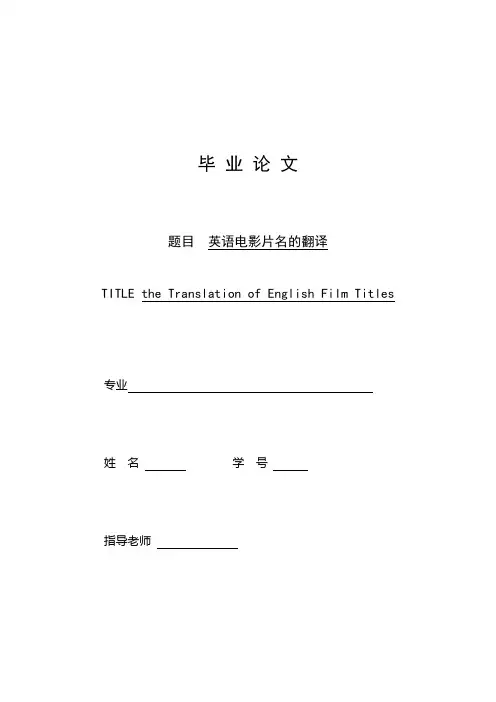
毕业论文题目英语电影片名的翻译TITLE the Translation of English Film Titles 专业姓名学号指导老师中文摘要经过一个多世纪的发展,电影如今已经成为了一种常见的娱乐方式。
而随着全球化的发展,人们有了更多的机会来欣赏制作精良、精彩纷呈的外国电影。
为了使中国观众明白整部电影的内容,就需要将电影翻译成中文,这其中就包括了电影片名的翻译。
作为影片不可或缺的一部分,电影片名有其独特的语言特色和民族文化内涵,是电影艺术性和票房商业性的集中体现。
电影片名翻译属于实用英语翻译的范畴。
一部电影片名的功能就是要吸引观众走进影院去观赏这部电影,这也同样是翻译电影片名的目的。
本文以起源于德国的功能派翻译理论为基础,对电影片名翻译的现象作出了解释,并分析了在目的论指导下,音译、直译、意译及改译几种翻译策略在英语电影片名汉译中的应用。
关健词: 电影片名翻译,功能翻译,目的论,翻译策略IAbstractHaving developed for over a century, film has become one of the most popular ways of entertainment for people. People have much more chances to appreciate the elaborate and excell ent films. In order to enable the Chinese audience to understand the film's content, thewhole film should be translated, including its title. As an indispensable part of a film, the title has its unique linguistic feature and culture connotation.Film title translation belongs to general English-Chinese translation. Its function is to push the audience to go to the cinema after seeing the title, which is also the skopos of film title translation.In this thesis, the author makes an analysis of the film title translation from the functional perspective. And the application of translation strategies, namely, transliteration, literal translation, liberal translation and adaption, is also analyzed with rich examples under the guidance of the functionalist approach.Keywords: film title translation; functionalist approach; Skopos theory; translation strategiesII中文文摘电影是一种集艺术性和商业性于一体的艺术形式,是最具有影响力的媒体之一。
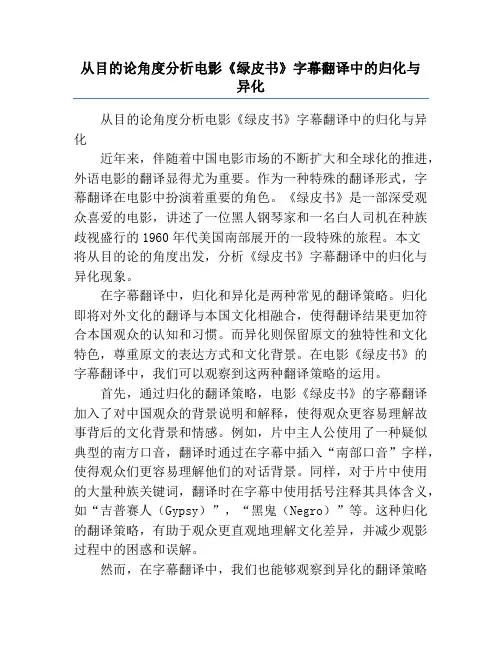
从目的论角度分析电影《绿皮书》字幕翻译中的归化与异化从目的论角度分析电影《绿皮书》字幕翻译中的归化与异化近年来,伴随着中国电影市场的不断扩大和全球化的推进,外语电影的翻译显得尤为重要。
作为一种特殊的翻译形式,字幕翻译在电影中扮演着重要的角色。
《绿皮书》是一部深受观众喜爱的电影,讲述了一位黑人钢琴家和一名白人司机在种族歧视盛行的1960年代美国南部展开的一段特殊的旅程。
本文将从目的论的角度出发,分析《绿皮书》字幕翻译中的归化与异化现象。
在字幕翻译中,归化和异化是两种常见的翻译策略。
归化即将对外文化的翻译与本国文化相融合,使得翻译结果更加符合本国观众的认知和习惯。
而异化则保留原文的独特性和文化特色,尊重原文的表达方式和文化背景。
在电影《绿皮书》的字幕翻译中,我们可以观察到这两种翻译策略的运用。
首先,通过归化的翻译策略,电影《绿皮书》的字幕翻译加入了对中国观众的背景说明和解释,使得观众更容易理解故事背后的文化背景和情感。
例如,片中主人公使用了一种疑似典型的南方口音,翻译时通过在字幕中插入“南部口音”字样,使得观众们更容易理解他们的对话背景。
同样,对于片中使用的大量种族关键词,翻译时在字幕中使用括号注释其具体含义,如“吉普赛人(Gypsy)”,“黑鬼(Negro)”等。
这种归化的翻译策略,有助于观众更直观地理解文化差异,并减少观影过程中的困惑和误解。
然而,在字幕翻译中,我们也能够观察到异化的翻译策略的运用。
异化的翻译策略保持原文的特色和风格,更好地传达原文的思想和情感。
在《绿皮书》中,主人公的口语表达时常出现非标准用法和口头语,这些特点为角色赋予了独特的魅力和个性。
而在字幕翻译中,这种非标准用法和口头语被较为保留地翻译,如“你挺机灵啊,巧立名目”(You are quick. Name your price.)等。
这样的异化翻译策略使得观众进一步了解角色的形象,并更好地感受到他们之间的亲情和友谊。
除了以上两种翻译策略,字幕翻译中还运用了其他策略来平衡归化和异化之间的关系。
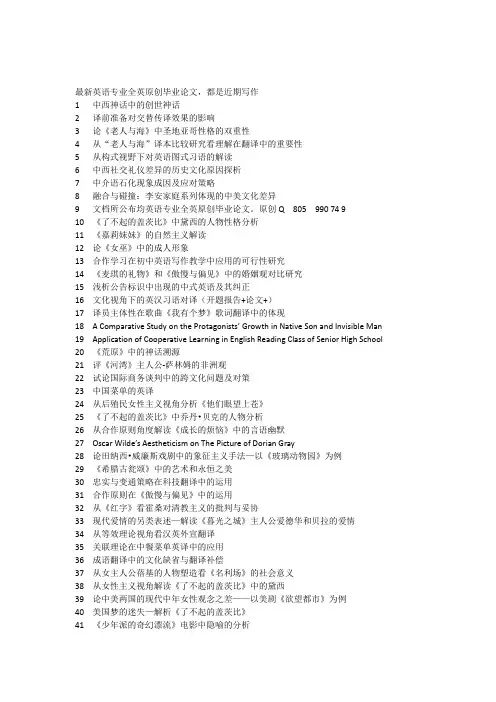
最新英语专业全英原创毕业论文,都是近期写作1 中西神话中的创世神话2 译前准备对交替传译效果的影响3 论《老人与海》中圣地亚哥性格的双重性4 从“老人与海”译本比较研究看理解在翻译中的重要性5 从构式视野下对英语图式习语的解读6 中西社交礼仪差异的历史文化原因探析7 中介语石化现象成因及应对策略8 融合与碰撞:李安家庭系列体现的中美文化差异9 文档所公布均英语专业全英原创毕业论文。
原创Q 805 990 74 910 《了不起的盖茨比》中黛西的人物性格分析11 《嘉莉妹妹》的自然主义解读12 论《女巫》中的成人形象13 合作学习在初中英语写作教学中应用的可行性研究14 《麦琪的礼物》和《傲慢与偏见》中的婚姻观对比研究15 浅析公告标识中出现的中式英语及其纠正16 文化视角下的英汉习语对译(开题报告+论文+)17 译员主体性在歌曲《我有个梦》歌词翻译中的体现18 A Comparative Study on the Pro tagonists’ Growth in Native Son and Invisible Man19 Application of Cooperative Learning in English Reading Class of Senior High School20 《荒原》中的神话溯源21 评《河湾》主人公-萨林姆的非洲观22 试论国际商务谈判中的跨文化问题及对策23 中国菜单的英译24 从后殖民女性主义视角分析《他们眼望上苍》25 《了不起的盖茨比》中乔丹•贝克的人物分析26 从合作原则角度解读《成长的烦恼》中的言语幽默27 Oscar Wilde’s Aestheticism on The Picture of Dorian Gray28 论田纳西•威廉斯戏剧中的象征主义手法—以《玻璃动物园》为例29 《希腊古瓮颂》中的艺术和永恒之美30 忠实与变通策略在科技翻译中的运用31 合作原则在《傲慢与偏见》中的运用32 从《红字》看霍桑对清教主义的批判与妥协33 现代爱情的另类表述—解读《暮光之城》主人公爱德华和贝拉的爱情34 从等效理论视角看汉英外宣翻译35 关联理论在中餐菜单英译中的应用36 成语翻译中的文化缺省与翻译补偿37 从女主人公蓓基的人物塑造看《名利场》的社会意义38 从女性主义视角解读《了不起的盖茨比》中的黛西39 论中美两国的现代中年女性观念之差——以美剧《欲望都市》为例40 美国梦的迷失—解析《了不起的盖茨比》41 《少年派的奇幻漂流》电影中隐喻的分析42 商标名的英译汉目的论研究——以洗护用品为例43 高中学生英语课堂口语交际活动的错误分析44 从《京华烟云》探析林语堂的女性观45 英语体育新闻标题的特点及翻译对策46 论《进入黑夜的漫长旅程》的悲剧成因47 对《名利场》中女主人公的性格特征分析48 试析《啊,拓荒者》中的生态伦理观49 设计中国际主义风格与民族主义风格的平衡50 从翻译角度浅析英语写作中的中式英语问题51 浅谈体态语及其在跨文化交际中的作用52 商务英语的语用特点及翻译53 男权制度下的悲剧——论《德伯家的苔丝》54 浅析《汤姆叔叔的小屋》中黑奴的命运55 Coincidences and Images in The Mayor of Casterbridge, Tess of the D’Urbervilles56 Politeness and Its Manifestation in Business Correspondence57 A Contrastive Analysis of Chinese and English Address Terms58 公示语翻译失当分析——以电影票等的顾客分析为例( )59 从原型批评理论角度分析威利•洛曼的悲剧60 虽不起眼,但不可或缺:从《洛丽塔》中的小人物看亨伯特悲剧的必然性61 商标翻译的本土化研究62 美国主流文化形成探析63 从目的论角度比较研究《彼得•潘》两个中文译本64 浅析英汉宗教死亡委婉语的异同65 Culture-oriented Strategies in Publicity Material Translation for Yangzhou City: a Perspective of Functionalism66 论中西方零售业企业文化的对比67 On the Pursuit of Ideal Home in Cold Mountain68 《围城》英译本衔接研究69 “邪恶的心灵”——剖析希斯克厉夫复仇的心理动机70 《野性的呼唤》中的人性和野性71 An Analysis of Symbolic Metaphor in To the Lighthouse72 英汉礼貌用语及交际策略的对比分析73 从传播美学分析国内畅销知名化妆品广告中的译文74 An Imitation of the Primitive Society: Evil of Human Nature in Lord of the Flies75 从《麦琪的礼物》看欧亨利的写作手法76 对美国总统就职演说的文体分析77 论国际商务非礼貌言语行为78 浅析《最蓝的眼睛》中的叙事艺术79 [毕业论文](经贸英语系毕业论文)以海尔集团为例浅析售后服务在企业营销中的作用80 从痛苦中顿悟—《麦田里的守望者》成长主题解读81 浅析跨文化交际中的中英社交称谓82 丘吉尔《就希特勒入侵苏联发表的讲话》的修辞赏析83 《月下独酌》两种英文译本之对比研究84 从合作原则谈影视翻译策略——以《功夫熊猫》为例85 伦敦英语在英语标准化过程中的作用86 从女性主义视角解读《飘》中斯嘉丽•奥哈拉的性格特征87 浅析文化差异对中美商务谈判的影响88 网络英语交际对会话合作原则的影响89 Problems Occured in the Process of the Chinese Learning English and Its Possible Solution90 美国宗教文化及价值观在其外交政策中的体现91 新课标下初中英语教师角色转变的研究92 从《河东狮吼》与《套礼服》的对比中分析中美婚礼的差异93 论英语小说中俚语的汉译94 The Influence of Cross-Cultural Communication on Translation95 安吉尔的精神悲剧—分析哈代笔下人物的心理发展过程96 女性主义视角下《白象似的群山》与《莳萝泡菜》中男性形象的对比研究97 浅析爱德华·摩根·福斯特《霍华德庄园》中的语言特色98 从广交会现场洽谈角度论英语委婉语在国际商务谈判中的功能与应用99 论《简爱》中的经济意识100 浅谈英汉人体部位的隐喻101 A comparison of values of money between Scarlett and Gatsby102 从女权主义视角分析《红字》中海斯特白兰的形象103 《人鼠之间》中两主人公乔治和雷尼的对比分析104 The Growth Topic in The Catcher in the Rye105 从关联理论看家庭会话冲突106 中美企业并购中的文化整合分析107 春节与圣诞节的对比研究108 从好莱坞电影中的中国元素看美国对中国意识观念的转变109 A Tentative Study of Affective Factors in Second Language Acquisition110 从爱伦·坡《黑猫》探讨人性的善良与邪恶111 从弗洛伊德的精神分析理论浅析《道林格雷的画像》中的主要人物112 从语义翻译与交际翻译看《红楼梦》中诗词的汉译英113 Passion & Religion — A Comparison between The Scarlet Letter and The Thorn Birds114 汉语句型习惯对英文写作的负迁移作用115 论《天路历程》的批判精神116 动物词在中英文化中的喻义及其翻译117 A Linguistic Analysis o f Barack Obama’s Inauguration Speech118 论密西西比河对马克吐温和《哈克贝利费恩历险记》的影响119 论“看,易,写”方法在旅游翻译中的应用120 从小说人物分析简•奥斯汀的情感智慧121 论自然主义在《野性的呼唤》中的体现122 等效理论框架下的中国菜肴英译研究123 弗吉尼亚•伍尔夫《海浪》的叙事技巧分析124 从跨文化传播角度论中国饮食文化资料的英译125 公示语的功能、语言特点及翻译126 《道连·格雷的画像》中意识与潜意识的对抗与结合127 An Analysis of Feminism in The Scarlet Letter128 从古至今的吸血鬼文化129 中世纪的典雅爱情:本质、渊源和影响130 从弗吉尼亚伍尔夫到多丽丝莱辛:论女性主义的发展——对比两位作家笔下塑造的女性形象131 商标翻译及商标翻译中的文化禁忌132 An Analysis of David’ s Dual Personality in David Copperfield133 中美商务英语信函的对比研究134 The Use of Symbols in A Farewell to Arms135 The Exploration of Black Female Characters in Toni Morrison’s Novels136 英语中源于希腊罗马神话主要神祇姓名词汇的认知探索137 从文化差异角度研究英文新闻标题翻译的策略138 论爱伦坡小说中的哥特式风格139 On the Female Initiation Theme in Little Women140 浅谈中美文化差异对商务谈判的影响141 论《儿子与情人》中保罗的爱情悲剧142 《呼唤》中倒装句汉译策略研究143 浅析广告发展现状及其未来发展趋势144 The Application of Corpus in Teaching English Writing145 A Comparison of the English Color Terms146 《荆棘鸟》中女性主义及女性意识觉醒的解读147 目的论视角下新闻标题汉译英研究148 英语X-ful词的形态与认知构建149 《到灯塔去》中的两性主义—抵达人类和谐的完美道路150 《三国演义》中带数字的词语翻译研究151 中英植物习语中的文化差异分析152 从女性主义视角看《蝴蝶梦》153 如果不复仇——论呼啸山庄中的爱与恨154 以学生为主体的教学在初中英语写作教学中的应用155 高中英语互动式课堂教学模式研究156 分析露丝的觉醒《接骨师之女》157 英语X-ful词的形态与认知构建158 从关联理论角度看英语广告语的修辞159 On Misreading in Reading Comprehension from the Perspective of Discourse Analysis160 从跨文化角度论谚语中的比喻与翻译161 论约翰•多恩诗歌中的张力162 中西方饮食文化比较研究163 英语委婉语的语用分析164 论反语的语用功能165 中英花卉隐喻下的情感叙事对比研究166 网上英语聊天的会话结构特征167 叶芝:无望的爱情,多变的风格168 英汉思维方式差异对英译汉结构处理的影响169 从成长小说角度解读《马丁•伊登》170 Pragmatic Failures in Translation of C-E Advertisements171 从跨文化交际层面谈口译译者能力的提高172 交际法在中学英语词汇教学的应用173 在幻想中回归童年──评析《爱丽丝漫游奇境记》174 《贵妇的画像》的过渡性特征的分析研究175 探究哈利波特的英雄成长之路176 The differences on advertising translations under the Chinese and Western cultures 177 不做房间里的天使——解读《爱玛》中的女性主体意识178 影响中学生英语学习的心理因素分析179 《高级英语》中某些修辞手法赏析180 从十字军东征看中世纪宗教冲突181 从校园流行语看中美学生思维方式的差异182 从文化差异角度看英汉习语的翻译183 从中西婚礼文化看中西方文化差异184 《动物庄园》中的黑色幽默分析185186 《野性的呼唤》中的自然主义187 试析《假如明天来临》的叙事艺术188 从《海狼》看杰克•伦敦的女性观189 The Loneliness in Far From the Madding Crowd190 论《外婆的家什》中的象征意义191 从文化差异角度谈国际商务谈判中的语言技巧192 A Study of Hawthorne’s Criticism on Puritanism in The Scarlet Letter193 王尔德唯美主义对现代消费文化的启示--以《道林格雷的画像》为例194 Scarlett O'Hara and Feminism195 英语介词的翻译196 合作原则在动画中的应用197 海明威“冰山原理”在《永别了,武器》中的应用及对写作的指导意义198 中医在英语世界的翻译与传播:过去与现在199 英文电影字幕翻译的原则和技巧。
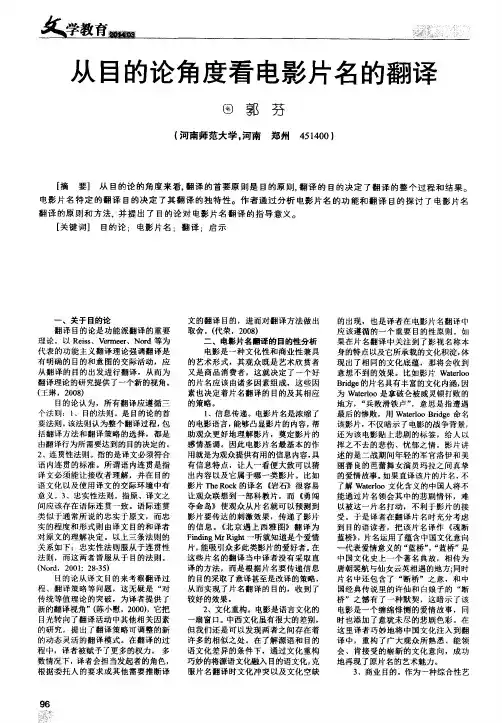
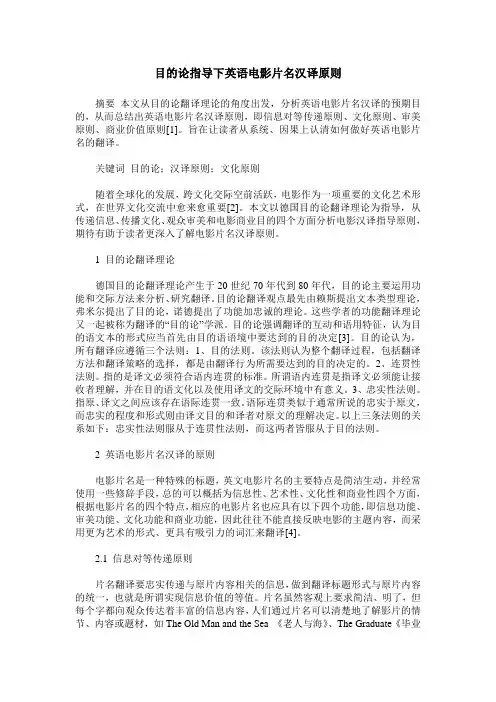
目的论指导下英语电影片名汉译原则摘要本文从目的论翻译理论的角度出发,分析英语电影片名汉译的预期目的,从而总结出英语电影片名汉译原则,即信息对等传递原则、文化原则、审美原则、商业价值原则[1]。
旨在让读者从系统、因果上认清如何做好英语电影片名的翻译。
关键词目的论;汉译原则;文化原则随着全球化的发展,跨文化交际空前活跃,电影作为一项重要的文化艺术形式,在世界文化交流中愈来愈重要[2]。
本文以德国目的论翻译理论为指导,从传递信息、传播文化、观众审美和电影商业目的四个方面分析电影汉译指导原则,期待有助于读者更深入了解电影片名汉译原则。
1 目的论翻译理论德国目的论翻译理论产生于20世纪70年代到80年代,目的论主要运用功能和交际方法来分析、研究翻译。
目的论翻译观点最先由赖斯提出文本类型理论,弗米尔提出了目的论,诺德提出了功能加忠诚的理论。
这些学者的功能翻译理论又一起被称为翻译的“目的论”学派。
目的论强调翻译的互动和语用特征,认为目的语文本的形式应当首先由目的语语境中要达到的目的决定[3]。
目的论认为,所有翻译应遵循三个法则:1、目的法则。
该法则认为整个翻译过程,包括翻译方法和翻译策略的选择,都是由翻译行为所需要达到的目的决定的。
2、连贯性法则。
指的是译文必须符合语内连贯的标准。
所谓语内连贯是指译文必须能让接收者理解,并在目的语文化以及使用译文的交际环境中有意义。
3、忠实性法则。
指原、译文之间应该存在语际连贯一致。
语际连贯类似于通常所说的忠实于原文,而忠实的程度和形式则由译文目的和译者对原文的理解决定。
以上三条法则的关系如下:忠实性法则服从于连贯性法则,而这两者皆服从于目的法则。
2 英语电影片名汉译的原则电影片名是一种特殊的标题,英文电影片名的主要特点是简洁生动,并经常使用一些修辞手段,总的可以概括为信息性、艺术性、文化性和商业性四个方面,根据电影片名的四个特点,相应的电影片名也应具有以下四个功能,即信息功能、审美功能、文化功能和商业功能,因此往往不能直接反映电影的主题内容,而采用更为艺术的形式、更具有吸引力的词汇来翻译[4]。
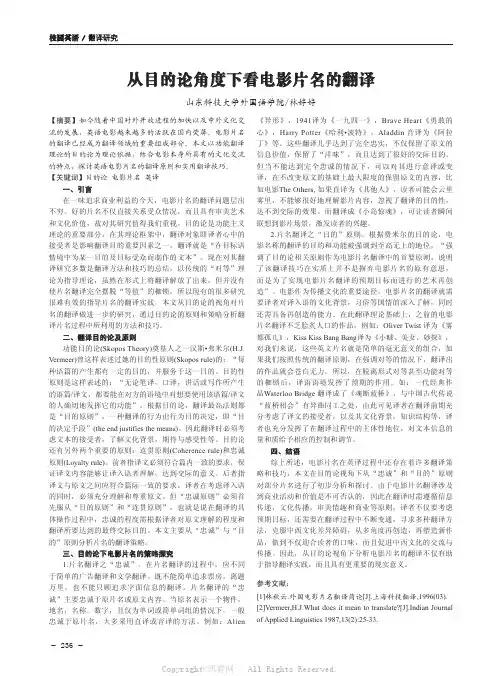
- 236-校园英语 / 翻译研究从目的论角度下看电影片名的翻译山东科技大学外国语学院/林婷婷【摘要】如今随着中国对外开放进程的加快以及中外文化交流的发展,英语电影越来越多的活跃在国内荧屏。
电影片名的翻译已经成为翻译领域的重要组成部分。
本文以功能翻译理论的目的论为理论依据,结合电影本身所具有的文化交流的特点,探讨英语电影片名的翻译原则和实用翻译技巧。
【关键词】目的论 电影片名 英译一、引言在一味追求商业利益的今天,电影片名的翻译问题层出不穷。
好的片名不仅直接关系受众情况,而且具有审美艺术和文化价值,故对其研究值得我们重视。
目的论是功能主义理论的重要部分,在其理论框架中,翻译对象即译者心中的接受者是影响翻译目的重要因素之一,翻译就是“在目标语情境中为某一目的及目标受众而制作的文本”。
现在对其翻译研究多数是翻译方法和技巧的总结,以传统的“对等”理论为指导理论,虽然在形式上将翻译解放了出来,但并没有使片名翻译完全摆脱“等值”的枷锁,所以现有的很多研究很难有效的指导片名的翻译实践。
本文从目的论的视角对片名的翻译做进一步的研究,通过目的论的原则和策略分析翻译片名过程中所利用的方法和技巧。
二、翻译目的论及原则功能目的论(Skopos Theory)奠基人之一汉斯•弗米尔(H.J. Vermeer)曾这样表述过她的目的性原则(Skopos rule)的:“每种语篇的产生都有一定的目的,并服务于这一目的。
目的性原则是这样表述的:“无论笔译,口译,讲话或写作所产生的语篇/译文,都要能在对方的语境中对想要使用该语篇/译文的人确切地发挥它的功能”。
根据目的论,翻译最高法则都是“目的原则”,一种翻译的行为由行为目的决定,即“目的决定手段”(the end justifies the means)。
因此翻译时必须考虑文本的接受者,了解文化背景,期待与感受性等。
目的论还有另外两个重要的原则:连贯原则(Coherence rule)和忠诚原则(Loyalty rule)。
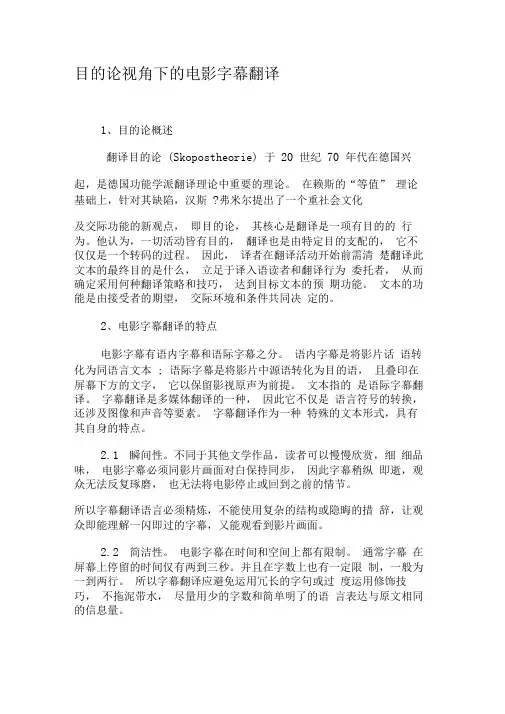
目的论视角下的电影字幕翻译1、目的论概述翻译目的论(Skopostheorie) 于20 世纪70 年代在德国兴起,是德国功能学派翻译理论中重要的理论。
在赖斯的“等值” 理论基础上,针对其缺陷,汉斯?弗米尔提出了一个重社会文化及交际功能的新观点,即目的论,其核心是翻译是一项有目的的行为。
他认为,一切活动皆有目的,翻译也是由特定目的支配的,它不仅仅是一个转码的过程。
因此,译者在翻译活动开始前需清楚翻译此文本的最终目的是什么,立足于译入语读者和翻译行为委托者,从而确定采用何种翻译策略和技巧,达到目标文本的预期功能。
文本的功能是由接受者的期望,交际环境和条件共同决定的。
2、电影字幕翻译的特点电影字幕有语内字幕和语际字幕之分。
语内字幕是将影片话语转化为同语言文本; 语际字幕是将影片中源语转化为目的语,且叠印在屏幕下方的文字,它以保留影视原声为前提。
文本指的是语际字幕翻译。
字幕翻译是多媒体翻译的一种,因此它不仅是语言符号的转换,还涉及图像和声音等要素。
字幕翻译作为一种特殊的文本形式,具有其自身的特点。
2.1瞬间性。
不同于其他文学作品,读者可以慢慢欣赏,细细品味,电影字幕必须同影片画面对白保持同步,因此字幕稍纵即逝,观众无法反复琢磨,也无法将电影停止或回到之前的情节。
所以字幕翻译语言必须精炼,不能使用复杂的结构或隐晦的措辞,让观众即能理解一闪即过的字幕,又能观看到影片画面。
2.2简洁性。
电影字幕在时间和空间上都有限制。
通常字幕在屏幕上停留的时间仅有两到三秒。
并且在字数上也有一定限制,一般为一到两行。
所以字幕翻译应避免运用冗长的字句或过度运用修饰技巧,不拖泥带水,尽量用少的字数和简单明了的语言表达与原文相同的信息量。
2.3通俗性。
电影作为一种大众媒体形式,面对的是普通大众,整个字幕翻译要考虑到影片的基调和作者的意图,注意观众的接受程度和市场反应。
译文应使用通俗化、大众化和与人们日常生活环境中息息相关的语言,让观众一看就懂,欣赏和体会到与源语影片相同的效果和感受。
最新英语专业全英原创毕业论文,都是近期写作1 浅析哈克贝利的叛逆精神2 解析《丽姬娅》中的哥特美学3 论《双城记》中的爱情4 广州及上海旅游景点公示语中英翻译错误及纠错对策5 An Application of Schema Theory in Interpreting6 中餐菜单英译的归化与异化7 A Survey on Western Culture Learning among Non-English Majors8 商标翻译中的功能对等9 分析福尔摩斯的性格特征10 中国公司简介的英译技巧11 分析嘉丽妹妹性格变化的原因12 公示语汉英翻译的问题与对策13 中美大学创业教育的比较和启示14 浅谈商务英语合同的翻译15 对《呼啸山庄》里所反映的人性的解读16 论英语新闻中的模糊语言17 浅析《还乡》中游苔莎的悲剧根源18 论威廉•戈尔丁《蝇王》中知识分子的悲剧19 中学英语任务型教学理论研究及应用现状评述20 A Comparison between Tess and Hester’s Tragic Destiny21 英语习语非稳定性结构特征研究22 源于真爱的结合:简爱的婚姻对当代人的启示23 On the Characteristics of Desert Island Literature from Lord of the Flies24 中英身势语中的文化差异25 Christ Love in Uncle Tom’s Cabin26 The Analysis of Feminism in Jane Eyre and Wuthering Heights27 浅谈中西文化中的思维差异28 《威尼斯商人》的新历史主义解读29 浅析《老人与海》中桑提亚哥的性格30 福克纳《我弥留之际》中达尔形象解析31 英语环境公示语翻译中的问题以及解决方法32 从《远眺》看翁达杰的立体主义叙事形式33 《纯真年代》中社会与个人的碰撞34 政论文的英译特点35 Foreign Brands Translated in Chinese36 On Romanticism in Ode to the West Wind37 基于语料库的中英色彩词文化差异研究38 从玛氏公司看英美文化对广告的影响39 《南方与北方》中玛格丽特·黑尔的人物分析40 英语习语汉译方法浅析41 从《阿Q正传》译本看民族文化的可译性42 Influences of Encouraging Words on Students In High School Classes43 英汉禁忌语对比研究44 《喜福会》中的文化身份分析45 On the Importance of China English as an English Variant46 《喜福会》中的中美文化冲突47 汽车广告功能分析48 从系统功能语法的角度分析奥巴马总统竞选辩论的语篇特点49 中美企业文化差异研究50 《野性的呼唤》中的自然主义分析51 超越性别的美——以《道林格雷的画像》为例52 从依恋理论看《呼啸山庄》主人公希斯克利夫悲剧性格的形成53 从文化视角谈中美儿童家庭教育观和教育方法的差异54 中英手机短信的修辞特点分析55 英汉禁忌语对比分析56 爱丽斯沃克小说《紫色》的妇女主义话语57 少儿英语游戏教学策略研究58 情感因素在英语教学中的作用59 《雾都孤儿》中南希双重性格分析60 The Inharmonious Elements in The Old Man and the Sea from an Ecological Perspective61 A Symbolic Analysis of Paradise Lost62 The Application of TBLT to Reading-teaching in Junior Middle School63 从目的论的角度浅析美国电影字幕翻译64 从《了不起的盖茨比》看美国梦的幻灭65 Etiquette and Protocol on Intercultural Business Negotiation66 To Obey or Rebel –A Study of Female Characters in Moment in Peking67 浅谈来自《圣经》的英语习语68 高中学生英语课堂口语交际活动的错误分析69 从功能对等角度分析英文电影片名汉译70 如何培养初中生开口说英语的习惯71 音意兼译—外来词中译之首选法72 英语非作格动词语义特征和句法属性研究73 Problems and Solutions in Senior English Listening Teaching74 论英汉成语翻译75 教师在初中教学中对学生的评价76 从文化差异视角论旅游文本翻译中的词汇空缺77 中西文化中颜色词的互译78 英语学习中语法的功能79 《小妇人》中四姐妹的命运80 An Analysis of Young Goodman Brown from the Perspective of Symbolism81 英语复合名词的认知语义研究82 论第二语言习得与教学中的互动83 浅谈非英语专业学生英语词汇的学习方法84 影响英语专业学生理解英语习语的因素调查85 从《哈利波特与火焰杯》看文学翻译中的文化冲突86 《儿子与情人》恋母情结分析87 论《都柏林人》中的情感瘫痪88 Aesthetic Arts in Allan Poe’s Poetry—An Analysis of Israfel and Annabel Lee89 从《印度之行》看东西方文化冲突90 《呼啸山庄》中凯瑟琳的悲剧分析91 《傲慢与偏见》中的微观反讽言语行为92 论《最后的莫西干人》中的印第安情结93 母语负迁移对中学英语写作的影响94 汉译英语足球新闻中修辞手法的策略95 汉语中英语借词及其语言文化影响96 《鲁滨逊漂流记》--世纪典型的殖民主义叙事文本97 A Comparison between Chinese and Western Food Cultures98 《榆树下的欲望》埃本悲剧命运探析99 建构主义理论下的教师课堂角色研究100 从文化差异的角度论文学译者的翻译技巧101 A Brief Study of Anti-female Bias in English102 《了不起的盖茨比》中的象征主义103 The ―Monstrosity‖ of Science: an analysis of Frankenstein104 从《哈克贝里﹒费恩历险记》看马克﹒吐温的幽默讽刺艺术105 中美广告语言文化异同研究106 跨文化因素对字幕翻译的影响107 A Study of Narrative Techniques in Barn Burning108 A Study on the Cross-Cultural Management in the Sino-American Joint-Venture Enterprises --With Special Reference to Changan & Ford Motor Company109 欧•亨利短篇小说的特点110 两个反叛的女人——姚木兰和斯佳丽之对比分析111 《尤利西斯》的象征艺术112 目的论视角下新闻标题汉译英研究113 从“鱼”浅谈中西文化差异114 哈克贝里·费恩与汤姆·索亚性格的对比分析115 跨文化交际中的障碍浅析及其解决方法116 《威尼斯商人》中夏洛克形象的解构与重建117 比较分析《野草在歌唱》与《倾城之恋》中女性的爱情婚姻观118 浅析商务谈判中非言语交际的核心地位119 合作学习在初中英语写作教学中应用的可行性研究120 《警察与赞美诗》与《二十年后》中的警察形象比较分析121 浅谈《永别了,武器》中的感伤主义122 《飘》中斯嘉丽人物性格分析123 《紫色》中“家”的解读124 The Analysis of Daisy in The Great Gatsby125 Exploring Differences Between Chinese and English Compliments126 外贸函电写作中存在的误区及其对策127 影响大学生英语自主学习的因素研究128 旅游景点名翻译的异化与归化129 谈双关语的翻译130 英汉称谓语的文化差异与翻译--以《京华烟云》为例131 Cultural Connotation and Translation of Animal Words in Chinese and English132 中国英语与中式英语的对比研究——从英汉民族思维差异的角度133 英语语义歧义分析及其语用价值134 浅析英汉基本颜色词之文化内涵--以“白”与“黑”为例135 爱情至上——浅析海明威笔下的女性形象136 法语给英语带来的影响137 A Study of Nonverbal Communication138 《好人难寻》的冷漠主题分析139 在异化社会里身份的迷失与精神上的顿悟--对索尔贝娄《晃来晃去的人》中主人公的剖析140 《了不起的盖茨比》中象征主义的研究141 跨文化交际中英语副语言的表现和交际功能142 The Tragic Elements in Far from the Madding Crowd143 试论英语词汇教学中的词块教学144 The Comparison and Translation of English and Chinese Idioms145 优秀小学英语教师课堂词汇互动教学的运用分析146 商务电子邮件中礼貌用语的运用147 论《紫色》中的性别暴力148 从《大卫科波菲尔》的女性人物塑造看现实主义与浪漫主义的结合149 The Comparison of Word Order between the Report at the th National Congress and Its English Version150 A Semantic Analysis of the Written Errors Committed by Chinese English Majors151 论口译的原则与技巧152 The Positive Impact of English Movies on Oral English153 英语委婉语的表达模式和应用154 中美幼儿教育对比研究155 On Symbolism in Hemingway's Cat in the Rain156 艾米莉狄金森诗歌中的动物意象研究157 解读《嘉莉妹妹》中的新女性形象158 广告翻译159 《了不起的盖茨比》中的象征艺术160 论汉语缩略语的英译161 从《奥兰多》看伍尔夫的双性同体162 《女勇士》中的华裔女性形象浅析163 从跨文化交际角度看电影片名翻译164 英汉爱情隐喻对比研究165 析《狮子和宝石》中拉昆来失败的原因166 反思任务型教学在高中教学中的应用167 《老人与海》中马洛林形象的不可或缺性168 《飘》与《倾城之恋》中的女性形象对比研究169 从《西风颂》初析雪莱的反传统人格特征170 Effects of First Person Narration on Thematic Expression in Araby171 从文化价值的角度解读歌王迈克尔•杰克逊的艺术影响172 从数字看中西方文化差异173 中西方餐桌礼仪文化对比174 在仙境中成长——《爱丽丝梦游仙境》的主题研究175 班德瑞曲名汉译策略之解析176 《小王子》的存在主义维度分析177 从礼仪角度谈中西文化的差异性178 约翰逊词典编纂特色探析179 The Language Features of Advertising English180 论英汉恭维语的差异181 从合作原则和礼貌原则的角度分析外贸函电中否定信息的传递182 从模糊性看古典诗词英译183 民族文化差异与广告语言创意184 译员主体性在歌曲《我有个梦》歌词翻译中的体现185 目的论在英文电影片名翻译中的应用186 英汉化妆品说明书对比及汉译策略187 Comparison between High and Low-context Culture in Language Expression 188 论《睡谷传奇》中的幽默元素189 克林顿总统就职演说之体裁分析190 浅析伍尔夫意识流小说中的叙事时间191 从文化视角看部分英汉习语的异同192 浅析造成盖茨比悲剧的因素193 罪与同情—论齐林沃斯的悲剧194 An Analysis of Vanity Fair from the Perspective of Interpersonal Function 195 顺应论视角中电影字幕汉英翻译研究——以李安电影作品字幕翻译为例196 浅析《傲慢与偏见》中伊丽莎白的性格和婚姻观197 唯美主义在道连格雷变化中的体现198 目的论指导下的英文影视名称的翻译199 互文性理论指导下的公示语汉英翻译200 中英颜色词的比较。
目的论视角下电影字幕翻译——以《被光抓走的人》为例目的论视角下电影字幕翻译——以《被光抓走的人》为例引言电影作为一种重要的艺术形式,能够跨越语言和文化的界限,传达不同国家和民族之间的思想和情感。
然而,由于语言的不同,观众在欣赏外国电影时通常需要依赖字幕进行理解。
因此,字幕翻译作为一种特殊形式的翻译活动,承载着重要的传播功能。
本文旨在以电影《被光抓走的人》为例,从目的论视角探讨电影字幕翻译的重要性、困境以及应对策略。
一、目的论视角下的电影字幕翻译1.1 目的论视角的基本理念目的论是翻译学中的一个重要学派,其核心理念是翻译的最终目的是为了满足特定的翻译需求。
从这个角度看,电影字幕翻译的目的就是使观众能够理解和体验电影的情节、人物和情感。
1.2 电影字幕翻译的挑战电影字幕翻译面临许多挑战,其中最重要的是如何平衡对原汁原味的保留和向观众传达正确信息的矛盾。
此外,时间和空间限制以及不同语言之间的文化差异也是电影字幕翻译的困境所在。
二、《被光抓走的人》的特点分析2.1 影片背景和主题《被光抓走的人》是法国导演勒玛尔丁的一部作品,讲述了一个关于爱与死亡的浪漫故事。
影片充满哲学意味,强调生命的瞬息即逝和对于生命的热爱。
2.2 语言与文化特点法语是影片中主要使用的语言,法国文化和社会背景也贯穿整个影片。
这对字幕翻译提出了要求,要在保留原汁原味的同时,尽可能向观众传达法国文化和情感。
三、《被光抓走的人》的字幕翻译实例分析3.1 字幕翻译的策略选择在字幕翻译中,为了准确地传达原片的内容,译者通常会选择直译或意译这两种不同的策略。
在处理《被光抓走的人》的字幕翻译中,译者需要综合考虑语言和文化的因素,选择适当的翻译策略。
3.2 字幕翻译的平衡与权衡在字幕翻译中,平衡和权衡是关键问题。
译者需要在保留原片的情感和意义的同时,照顾观众对于语言和文化的理解。
例如,在翻译歌曲歌词时,译者需要平衡原文的韵律和意义。
四、电影字幕翻译的值得借鉴之处4.1 语言的美感传达电影字幕翻译不仅仅是语言的转换,还需要将电影语言的美感传达给观众。
第33卷第4期 Vo1.33 No.4 兰州教育学院学报
JOURNAL OF LANZHOU INSTITUTE OF EDUCATION 2017年4月
Apr.2017
从目的论视角看英文动画电影片名的翻译 匕莹 (中山大学新华学院外国语学院,广东广州510520)
[摘要]动画电影作为一种重要的文化艺术交流形式,其片名翻译也是一项有目的的跨文化交际翻译行为。本文从 翻译目的论的视角对动画电影片名翻译的特点与方法进行探讨,以期使动画电影片名翻译能更好地为目的语观众所接 受,实现其商业价值。 [关键词]动画电影片名翻译;目的论;翻译方法 [中图分类号】H319【文献标志码]A[文章编号]1008-5823(2017)04-0148-03[收稿日期]2017—02—23
动画电影是当今电影产业的一个重要分支,是文 化的一种艺术表现形式。近几年来梦工厂、迪士尼等 公司出品的动画电影大量涌人中国市场,其精良的制 作水准和良好的观众口碑使得动画电影票房纪录被 不断打破,其中几部如Kung Fu Panda(《功夫熊 猫》)、Frozen(《冰雪奇缘》)、Zootopia(《疯狂动物 城》)甚至成为了现象级影片,跻身成为各大门户网站 和舆论的热门话题。作为吸引观众走进影院观看电 影的第一风向标,电影片名功不可没,成功的动画电 影片名翻译有着极强的导视作用。因此对于动画电 影片名翻译研究的迫切性和重要性也就不言而喻了。 与强调翻译要忠实于源语言文本的传统翻译理论不 同,翻译目的论给研究英文动画电影片名翻译提供了 一个新的视角,其能综合考虑不同国家文化、习俗、语 言等方面存在的差异,深入挖掘片名翻译的目的性本 质,指导译者灵活运用各种翻译方法准确传神地完成 片名翻译,给翻译实践提供了全新的思路和可操作 性。 一、动画电影片名的特点 电影片名是电影的“眼睛”,其意义就在于要在有 限的时间及篇幅内向观众传递最大限度的信息量,以 达到“画龙点睛”之效。好的电影片名应该既能体现 电影内容的精髓,让人一目了然,又能迅速吸引观众 眼球,激发其强烈的观看欲望,这对于电影宣传和票 房影响都起到不容忽视的作用。动画电影以其丰富 的想象力、高超的艺术创作性、夸张的造型设计、色彩 丰富的动态画面而与其他电影门类区分开来,因此动 画电影片名除了大众电影片名所具有的言简意赅、短 小精炼、朗朗上口的特点之外,还具有以下特点: (一)具有奇幻色彩 动画电影大多描述的是虚拟世界发生的主题故 事,无论是故事情节、人物安排,还是制作中的画面色 彩度和空间感无不超越了常规大众电影的种种局限 性,想象力无穷,奇幻色彩浓厚。同时动画电影的观 影人群多为儿童及青少年,采用新奇的、魔幻式的动 画电影名称会更加吸引他们的注意力,激发起观看的 好奇心,如Rapunzel(《魔发奇缘》)、Frozen(《冰雪奇 缘》)、Alice in Wonderland(《爱丽丝梦游仙境》)等等。 “魔发”“奇缘”“梦游”等一系列词都突出了电影的奇 幻色彩。 (二)具有动态画面感 动画电影由一帧帧动画构成,画面场景切换迅 速,地点、人物、色彩变化多样,并且所有的生物和物 品在动画电影里都可以是有生命的,活动的。动画电 影名应具有一种视觉动态效果,让观众一听到名字, 就有一种画面在眼前浮动的效果,激发观众想象力, 增加对电影的期待感。动画电影Up(《飞屋环游记》) 非常好地体现了这一点,“飞屋”“环游”,一幅房屋在 空中飞翔去周游世界的即视感立刻呈现,生动地体现 了动画电影的动态感。 (三)用词大胆夸张 动画电影充满奇思妙想,经常刻画一些现实生活 中不可能发生的事物,因此运用一些大胆、夸张的片 名既能够反映出电影故事情节的跌宕起伏、复杂多 变,同时也能激起观众的观影热情,达到吸引眼球的 效果。Rio(《里约大冒险》)、Zootopia(《疯狂动物 城》)中的“大冒险”“疯狂”会让观众有想一睹为快、 一探究竟的冲动。 二、目的论对动画电影片名翻译的启示 (一)目的论 翻译是用一种语言形式把另一种语言形式里的 内容重新表现出来的语言实践活动。汉斯・弗米尔 (Hans J.Vermeer)摆脱了以原语为中心的等值论的 束缚,创立了功能派的奠基理论——目的论(Skopos・ theorie)。Skopos是希腊语,意思为“目的”,也就是译 文的目的。目的论认为翻译是一种有目的的互动行
最新英语专业全英原创毕业论文,都是近期写作1 中国文化元素在功夫熊猫中的体现及其翻译2 中西方语言和文化间的相互影响3 功能翻译理论关照下的新闻英语标题翻译4 阶级矛盾导致的爱情悲剧―<<呼啸山庄>>解读5 从fans和PK看西方文化对汉语言文化的冲击与影响6 哥特式风格特征在《远大前程》中的诠释7 浅析英文爱情诗的特点与翻译方法8 从电影《刮痧》看中西方文化差异9 简•奥斯汀《诺桑觉寺》中人物对爱情和婚姻的不同态度10 论新闻英语中隐喻的运用及其翻译技巧11 文档所公布均英语专业全英原创毕业论文。
原创Q 799 75 79 3812 Eco-Critical Reading of The Call of the Wild13 《红字》的悲剧成因分析14 A Study of AP’s News Reports from the Angle of Cooperative Principle15 英文歌词翻译的原则和技巧16 The Exploration of Tragic Fate of Tess17 《喜福会》中的女性身份重建18 对《德伯家的苔丝》中纯洁一词不同理解的分析19 清教主义对美国文化的影响20 浅议提高英语阅读速度的方法21 英汉基本颜色词的文化内涵对比研究22 浅析小学英语课堂的有效提问23 运用目的论对比分析爱伦•坡《黑猫》的两篇中文译本24 Differences Between Chinese and Western Cultures in Gift-giving Customs25 从CIF与CIP的比较看CIP的优势26 提高英语听力的有效策略及教学启示27 浅谈商业广告的翻译28 双关语在英语广告中的应用与翻译研究29 从功能对等的角度浅析汉语成语中数字的翻译30 从功能对等理论看《生活大爆炸》中幽默字幕的汉译31 美国宗教文化及价值观在其外交政策中的体现32 《宠儿》的非线性叙事模式33 《收藏家》中空间与人物心理关系的解读34 (英语系经贸英语)浅谈成本领先策略对于企业发展的影响--以格兰仕为例35 接受美学视角下莫言《红高粱家族》英译研究36 《外星人》电影海报的多模态话语解析37 国外品牌翻译及其接受度研究38 An Analysis of Symbolism in The Awakening39 小议非英语专业大学生英语口语能力的培养40 解析名词化与商务语篇的汉英翻译41 浅议女性哥特主义在《暮光之城》中的体现42 论《儿子与情人》中的恋母情结43 论地理位置对中美民族性格的影响44 《鲁宾逊漂流记》与《桃花源记》中乌托邦思想之比较45 观《麦田里的守望者》的教育失败46 违反合作原则所表达的会话含义—以《越狱》中Theodore Bagwell话语为例47 Pecola’s Blues--A Reading of The Bluest Eye48 Confuci anism’s Influence on Transcendentalism:Reflection on Emerson’s and Thoreau’s Philosophy49 电影片名翻译商业化所引发的问题及应对策略50 英汉思维方式差异对英译汉结构处理的影响51 The Comparison of the Two Main Characters in Daniel Defoe’s Roxana and Emily Zola’s Nana52 还《失乐园》中撒旦的本来面目53 华兹华斯与拜伦自由意识的主要区别54 试析翻译中的“假朋友”55 涉外商务用餐中的非言语交际56 从《一间自己的房间》分析弗吉尼亚•伍尔夫的女性主义思想57 古诗词英译关于夸张的翻译策略研究58 唯美主义与奥斯卡•王尔德的《道林•格雷的画像》59 我国高中生英语学习动机研究60 论《简爱》中话语的人际意义61 On Freudian Interpretation of Dreams In Sense and Sensibility62 是受害者还是恶棍——重新解读夏洛克63 Women’s Image in Pygmalion64 浅析福斯特《霍华德庄园》中的人文主义65 禅宗思想在艾米莉迪金森诗歌中的体现66 论《一个温和的建议》中的黑色幽默67 简析诚信在对外贸易中的作用68 论《呼啸山庄》中希斯克利夫的心路历程69 从《在路上》看“垮掉的一代”70 The Application of Symbolism in The Great Gatsby71 从合作原则角度解读《成长的烦恼》中的言语幽默72 A Brief Analysis of Public Sign Translation73 A Comparative Study on Lin Daiyu and Xue Baochai74 论索尔•北娄《赫索格》中现代人的焦虑75 英语专业本科毕业论文摘要的体裁分析76 A Comparison of the English Color Terms77 翻译的对等性研究及其应用78 The Alternation of Language: A Study of Microblogging V ocabulary79 商务英语写作中的语用失误研究80 论《黑夜中的旅人》中主人公的信仰冲突与融合81 从功能翻译理论看《风声》的字幕翻译策略82 任务型教学在初中英语的实施情况研究83 通往真正的人性之路:《紫色》中西丽的转变84 论世纪年代以来美国文化冲击对中国青少年的影响及教育策略改革的应对措施85 从《大卫科波菲尔》中看狄更斯的道德观86 伏尼契小说《牛虻》中主人公性格分析87 从《胎记》看霍桑对科学的态度88 从《老人与海》看海明威的人生观89 跨文化交际背景下英语禁忌语探析90 探究瓦尔登湖的积极现实意义——倡导和谐生存发展模式91 体育新闻标题汉译中修辞的作用——以历届奥运会为例92 英汉习语的概念隐喻对比研究93 On Translation Strategies of Online Subtitle Translation Group94 关联理论在中餐菜单英译中的应用95 论中美家庭教育——以《喜福会》为例96 翻译中的文化差异97 浅析托妮•莫里森《恩惠》中的母爱98 《海的女儿》中安徒生的悲剧情结分析99 Transcendentalism in Thoreau's Walden100 中英身势语中的文化差异101 《中国日报》与《纽约时报》灾难新闻之比——以系统功能语法为视角102 商务英语信函中的语用失误分析103 年代美国梦在《了不起的盖茨比》中的折射104 《瓦尔登湖》生态批评视角分析105 中西文化差异分析—以国际商务谈判为视角106 象征主义手法在《白鲸》中的运用107 英汉死亡委婉语的文化差异及其分类对比108 惠特曼的人文主义思想对美国现代诗歌创作和中国诗歌创作的影响——以《自我之歌》为例109 凯特•肖邦小说《觉醒》中的超验主义思想分析110 从电影《阿凡达》透视美国文化111 《飘》中生态女性意识的研究112 从《道连格雷的画像》谈唯美主义艺术观113 文化差异对习语翻译的影响114 《老人与海》中的象征主义115 分析《贵妇画像》中伊莎贝尔的个性特点116 Hawthorne’s Feminism Consciousness in The Scarlet Letter117 从《纯真年代》的女性角色看旧纽约的女性地位118 欧•亨利作品中的人生的价值探索119 合作学习在初中英语写作教学中应用的可行性研究120 论跨文化商务中的非言语交际121 论考琳•麦卡洛《荆棘鸟》中的女性形象122 《了不起的盖茨比》中象征主义的研究123 论《老人与海》中人与自然的矛盾性与和谐性124 从功能对等理论看汉语文化负载词的英译125 英汉问候语对比研究126 对《一小时的故事》的批评分析127 The Glossology and Translation of Rhetorical Devices of Harry Potter128 中西方婚礼礼服颜色的对比研究129 论英汉基本颜色词的文化内涵差异130 试析《野性的呼唤》中的生态观131 A Comparison of the English Color Terms132 互联网媒体对汉语纯度影响的研究133 The Comparison of Diet Culture between China and America134 A Comparison of the English Color Terms135 从传统节日庆祝方式的角度比较中英文化差异136 通过象征主义、梭罗的自然思想和梭罗的个人主义析《瓦尔登湖》137 A Comparative Study on the Celebrations of Traditional Chinese and Western Festivals 138 英语学习能力与风格的性别差异研究139 身势语在演讲中的重要性和运用研究140 论《麦田里的守望者》的意义141 浅谈中西体态语的差异142 英文外贸合同中表时间介词的使用和翻译143 房地产广告的英译研究144 浅析卡夫卡小说中的荒诞意识145 不伦,还是不朽?--从柏拉图的哲学理论视角解读《洛丽塔》146 从中英文动物词汇看中西方文化差异147 生活在夹缝中的畸形人——评《小镇畸人》148 中西校园流行语的文化对比149 A Comparison of the English Color Terms150 企业资料的翻译原则151 项目教学法在英语写作课中的应用152 中英广告中的双关语探析153 外来词的翻译方法初探154 废墟上成长起来的南方新女性155 从欧•亨利笔下的小人物探寻人生的真正价值156 《老友记》中言语幽默的修辞学思考157 对当今中国大学英语作为第二外语的教学方法的观察和思考158 浅论广告英语的修辞特色159 《永别了,武器》中的自然象征意义160 分析女性语言特点在英语委婉语中的体现——以《绝望主妇》为例161 浅析莫里森名作《最蓝的眼睛》中查理的性格特点162 《彼得潘》中的“成长”主题163 中西方商务礼仪的差异164 A Brief Study of Anti-female Bias in English165 语言经济学视角下的商务英语信函写作166 汉语成语英译过程中动物形象的转换167 从生态女性主义视角解读《喜福会》168 从自然主义角度解读《苔丝》的悲观主义169 《傲慢与偏见》中的婚姻观170 An Analysis of Gothic Features in Jane Eyre and Wuthering Heights171 析《道林格雷》中王尔德用来揭示生活与艺术冲突的方法172 研究网络语言的特点,影响以及其规范性173 从《丧钟为谁而鸣》看海明威死亡情节成因174 浅析库尔特•冯尼古特《猫的摇篮》中的黑色幽默175 从中美送礼习俗分析两国文化价值观的差异176 谈目的论视角下的商标翻译177 英国湖畔派诗歌的语言特点及其汉译178 从餐桌礼仪看中美饮食文化差异179 问题类型对TEM阅读成绩影响的实证研究180 Which Woman is More Popular in Modern Society:A Comparative Study of Tess and Jane 181 从文化差异的四维度读解中法葡萄酒文化182 浅析跨文化交际中的体态语183 《喧哗与骚动》中没落的悲剧184 合作原则视角下中美情景喜剧中言语幽默的对比研究185 《麦琪的礼物》和《傲慢与偏见》中的婚姻观对比研究186 美国电影中的中华文化运用得与失的研究187 论赫尔曼•梅尔维尔《白鲸》中的象征主义188 模糊限制语在求职中的应用研究189 A Comparison between Scarlett O’Hara and Jane Eyre from the Perspective of Feminism190 “同一性危机”——浅析汉娜的悲剧人生191 Analysis of Social Condition from American Gold Rush in The Call of the Wild192 A Research on V ocabulary Learning Strategies Employed by Non-English Majors in the CALL Environment193 浅谈英汉颜色词在使用中的文化差异194 目的论视角下新闻标题汉译英研究195 影响中学生英语学习的心理因素分析196 从《爱玛》看简•奥斯丁的爱情观197 浅析《麦田里的守望者》中的部分重要象征物198 The Linguistic Features of American Inaugural Address199 从生态批评角度看艾米丽狄金森的诗歌200 英语习语的文化内涵。
从目的论角度谈英文电影片名的翻译
随着中国对外开放进程的加快及中外文化交流的日益广泛, 英文电
影正越来越多地涌入中国大陆市场。 作为英文译制片不可 或缺的部分,
中文译名架起了一座把电影和观众初步联系在一起 的桥梁。电影片名的
翻译已成为翻译领域一个越来越重要的组成 部分。关于电影片名的翻译
及其研究, 普遍都以传统的“对等” 翻译理论作为指导思想。 这样
做, 虽然将翻译从形式的枷锁中解 放了出来, 但是, 它并没有使电影
片名的翻译摆脱“对等”的束 缚,也不能解释为什么有的影片译名违反
对等标准但经实践检验 十分成功, 因而难以有效地指导翻译实践。 本
文将从功能派翻译 理论中的目的论角度及片名翻译的案例,分析英文影
片名的翻 译。
功能派翻译理论的形成大致经历四个阶段。第一阶段,
Katharina Reiss
提出了功能派理论的雏形,她认为译者应该优 先考虑
译文的功能特征而不是对等原则。第二阶段是由
Hans
J.Vermeer 在 Katharina Reiss
的基础上创立了翻译目的论,即
Skopos theory
,他根据行为学的理论提出“翻译是一种人类行 为,而
任何行为都有目的性”, 翻译所要遵循的首要原则是“目 的法则”。第
三阶段, Justa Holz-Manttari 进一步发展了功能 派翻译理论,视翻
译为“为取得某一特定目的而进行的复杂活 动”,译者根据自己的特定
文化知识阐释“他者”。第四阶段, 功能派的主要倡导者
Christiane
Nord
在目的论的翻译法则中加 入了忠诚原则,进一步完善了理论。在电
影片名的翻译过程中, 采用目的论的方法, 使电影名的翻译摆脱了“对
等”的束缚, 降 低了原电影片名在翻译过程中的指导与支配地位, 更
有利于译者 在翻译过程中发挥自身的能动性, 发挥目的语的优势, 更
准确地 译文。
电影作为各国文化交流的重要组成部分, 同时它具备的高度 商业
性, 从某种意义上来说, 进口影片的受欢迎程度与译名有一 定的联
系。贺莺提出在电影片名的翻译的过程中要考虑四大价 值:信息价值、
文化价值、审美价值和商业价值。信息功能是指 片名要在一定程度上概
括影片的内容,使观众能了解影片的主 旨。文化功能是指片名所承载的
文化信息, 片名的翻译过程中要 充分地考虑文化背景、 民族文化的特
点以避免跨文化交际而产生 的误导和误解。 审美功能是指赋予片名语言
和艺术的美感, 音意 俱美、 达意传神的影片名能给观众以美好的艺术
享受。 商业功能 是指在片名的翻译过程中要考虑其商业性, 如果译者
能充分地把 握原片名和译语的文化特征和审美情趣, 创造出激发观众审
美愉 悦进而产生观看的译名, 就有助于提升一部电影的商业价值, 带
动其他电影商业功能的实现。 从以上几个方面来看, 在电影片名 的翻
译过程中应该充分考虑片名所承载的各项价值功能, 力求使 译名在观众
中产生预期的效果, 实现影片名翻译的预期目的和功 能。
以目的论为指导, 我们在电影片名翻译的过程中, 考虑到以 上四
大价值,可采用不同的翻译方法,如音译、直译、意译等方 法达到理想
的效果。
音译法。在一些如以地名、 人名命名的影片可以采用音译法,
这样可保留原文的韵律节奏和异域特色,如Chicago《芝加哥》,
为世界知名小说拍成的影片名翻译的过程中采用音译法更能让 观众感到
熟悉及具有亲切感,如 Jane Eyre《简?爱》,Tess《苔
丝》, Romeoand Juliet 《罗密欧与朱丽叶》等。当然,并不是 所有
这类型的影片都必须采用音译法, 有些片名如果直接音译就 不能获得理
想的效果,如 Thelma and Louise ,如果根据音译法 则可翻译为《塞
尔玛与路易斯》,这样翻译的话很有可能会使此 影片石沉大海,最后该
影片被翻译成了《末路狂花》,取得了当 年千万美元的票房收入。
直译法。 直译法是指在符合译文语言规范的前提下, 既保持 原文
的内容,又不改变其修辞或措辞特征(如形象、比喻、民族 或地方特色
等) 的译文为直译。 在影片名的翻译过程中如果是主 题明确的片名就
可采用直译法, 这样能让观众一目了然地了解此 影片。如
A
Streetcar NamecDesire《欲望号街车》,RomarHoliday
罗马假日》, Schindler 's List 《辛德勒的名单》,
Million
Dollar Baby《百万美元宝贝》,Womeiin Love
《恋爱中的女人》,
Dance with Wolves 《与狼共舞》, My Fair Lady
《窈窕淑女》,
Slumdog Millionaire 《贫民窟的百万富翁》, The Pursuit of
Happiness
《当幸福来敲门》等。
意译法。意译法,即保持原文的内容,但不能同时兼顾其修 辞特
点, 不得不改变说法的译文为意译。 意译并不等于随心所欲 地偏离原
文, 意译只是用不同的译文形式, 表达与原文相同的内 容。如
Cinderella 《灰姑娘》, Top Gun 《壮志凌云》 Catch Me
If You Can被翻译成了《猫鼠游戏》及《逍遥法外》, Sleepless
Titanic 《泰坦尼克号》, Patton
《巴顿将军》等;特别在一些
in Seattle 《西雅图不眠夜》, Cloud Atlas 《云图》, Life of
Pi
《少年派的奇幻漂流》等。
而 Madison County Bridge 《廊桥遗梦》, Ghost 《人鬼情 未
了》,Bathing Beauty《出水芙蓉》,Forrest Gump〈〈阿甘正
传》,Gonewith the Wind《乱世佳人》
,
The Pursuit of Happiness
当幸福来敲门》 等与影片内容相符的译名, 更是深受观众的喜
爱。电影是一门文化与商业兼备的艺术, 因此在影片名翻译的过 程中需
要考虑各个方面的因素。好的译名能给人留下深刻的印 象,使影片锦上
添花,但不好的译名能使明珠蒙尘。目的论突破 了传统翻译理论, 提出
了翻译行为并不是单纯的语际转换, 而是 一种有目的的行为活动,还是
一种有目的的跨文化的交际活动, 从而进一步丰富了翻译理论, 并为影
视翻译实践开辟了一个新视 角。